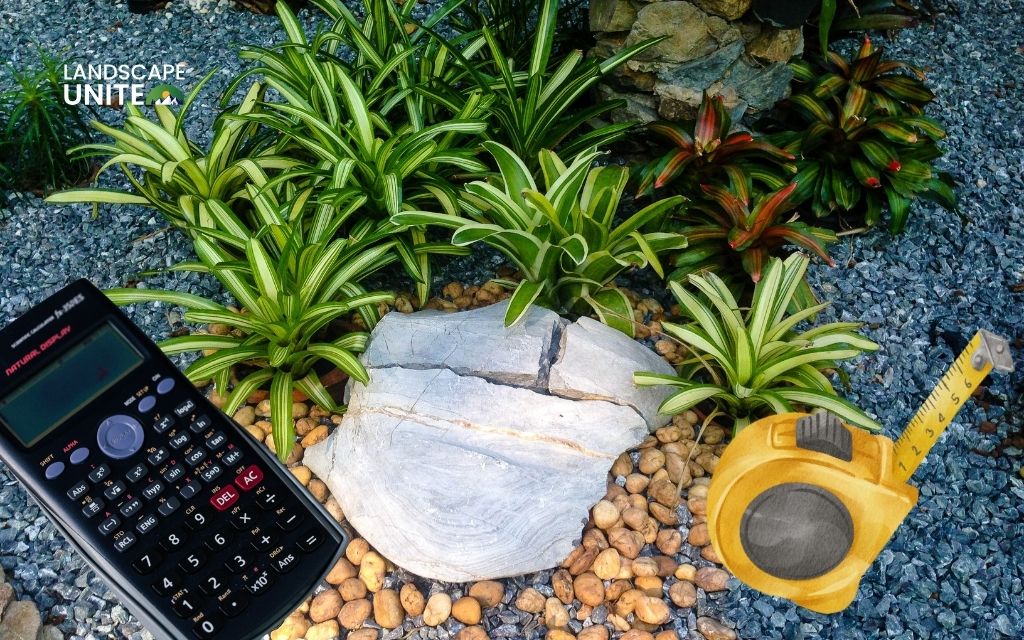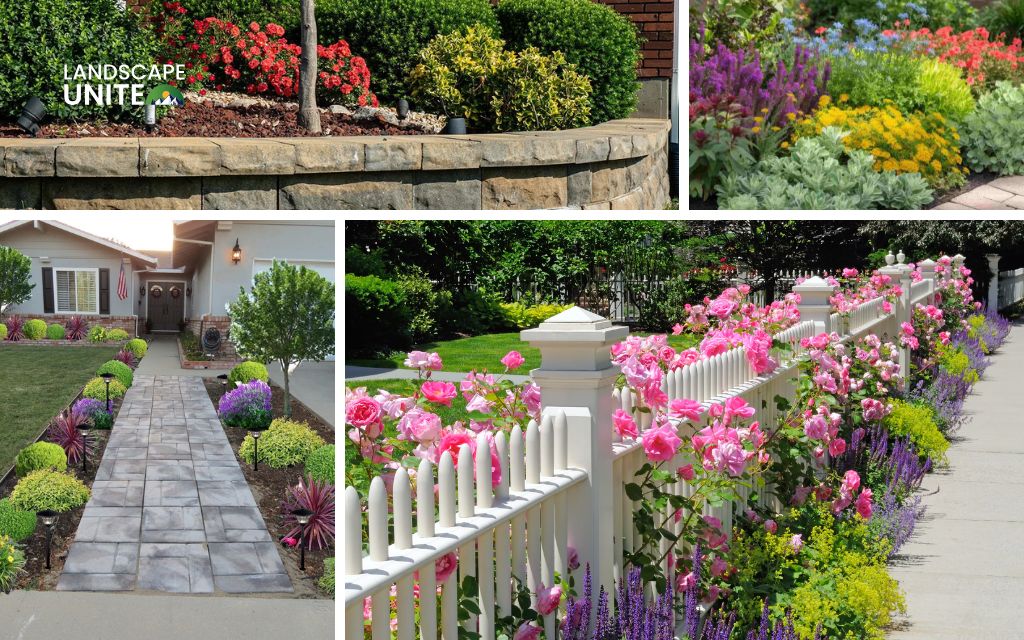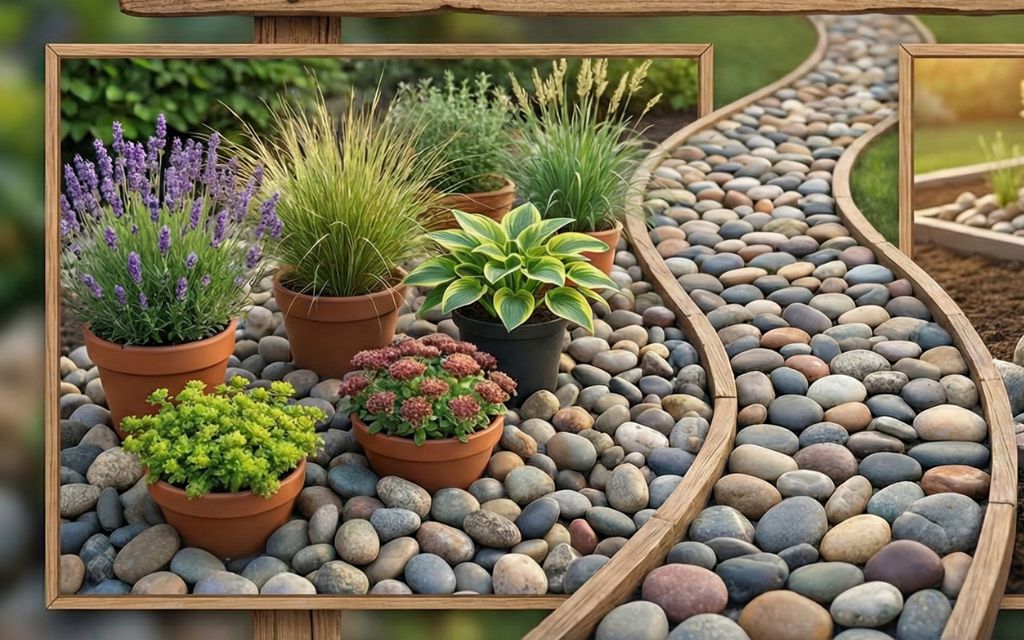Red plants have an unmistakable ability to transform ordinary garden spaces into breathtaking landscapes filled with passion, energy, and visual drama.
Whether you’re looking for red flowering plants to brighten your borders, vibrant red blooming plants for containers, or stunning red foliage to create year-round interest, the world of red color plants offers endless possibilities for US gardeners across all hardiness zones.
This comprehensive guide showcases over 50 of the most spectacular red plants available, helping you discover the perfect varieties to bring bold, beautiful color to your outdoor spaces – no matter your experience level or climate zone.
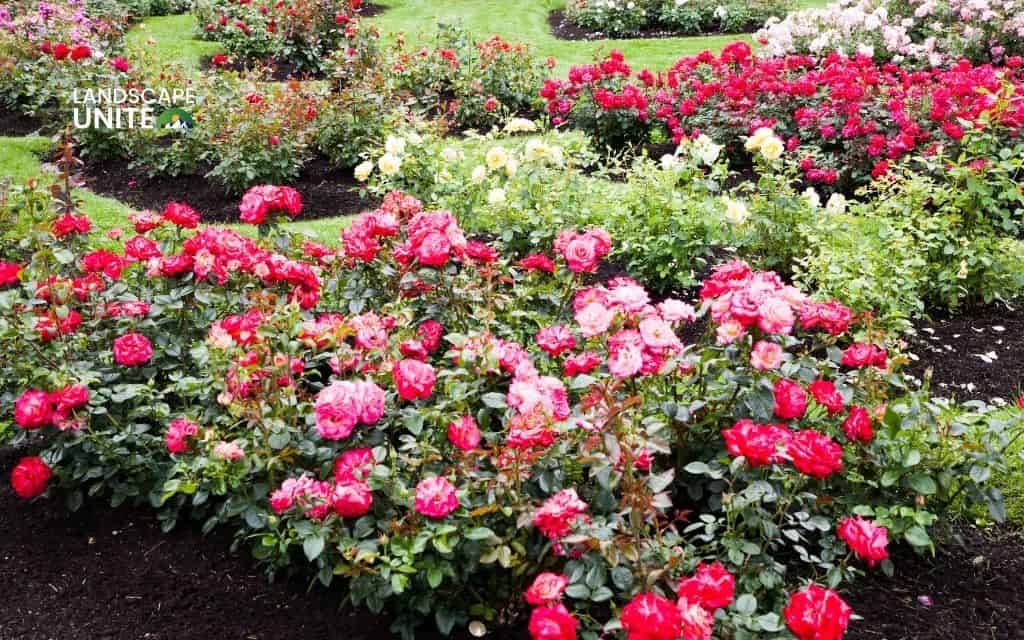
50 stunning red plants & flowers for your garden
Red flowers for flower beds: Annual favorites
Geranium (Pelargonium)
These reliable red flowering plants are garden staples for good reason. Geraniums produce clusters of vibrant scarlet blooms from spring through fall, thriving in full sun to partial shade.
Perfect for flower beds, containers, and window boxes, they’re drought-tolerant once established and require minimal deadheading.
Hardy in zones 10 – 11, but grown as annuals elsewhere.
- Light: Full sun to partial shade
- Water: When top 1 – 2 inches of soil is dry
- Mature Size: 12 – 24 in. tall, 12 – 18 in. wide
- Difficulty: Easy
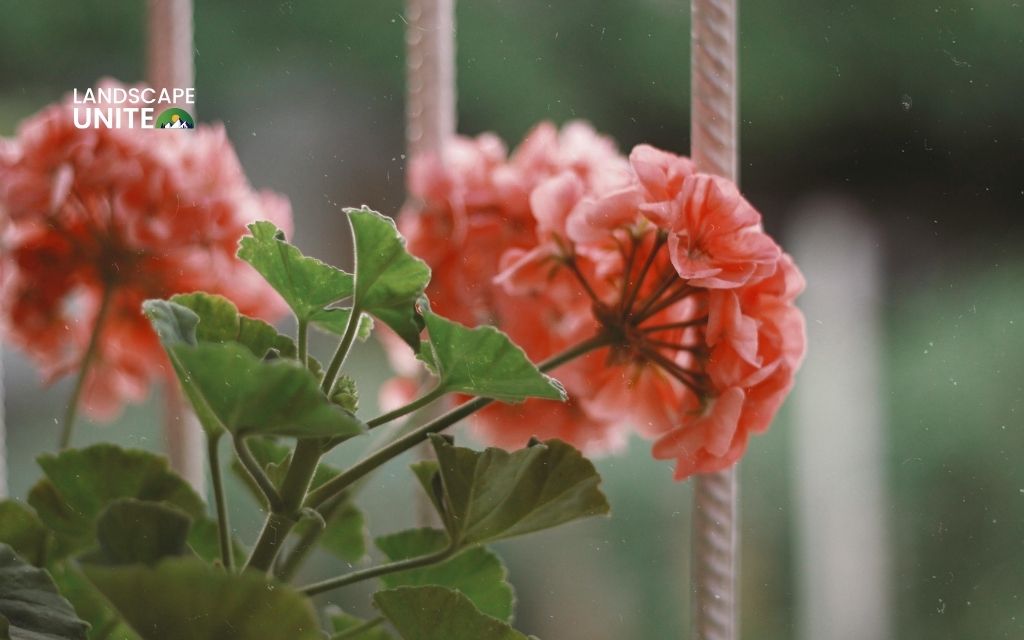
Petunia
These vigorous annuals cascade beautifully from hanging baskets and containers, producing wave after wave of red blooms throughout summer.
Plant in full sun and fertilize regularly for the most prolific flowering. They’re excellent red garden flowers that tolerate heat and humidity exceptionally well.
- Light: Full sun
- Water: Keep soil consistently moist
- Mature Size: 6 – 18 in. tall, 12 – 36 in. wide
- Difficulty: Easy
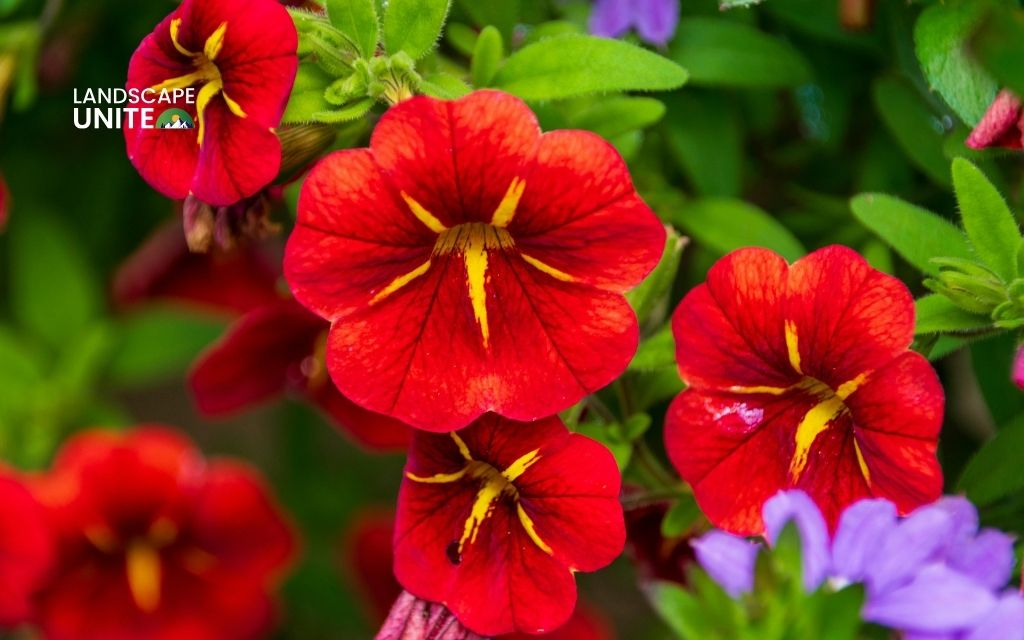
Zinnia
Heat-loving zinnias are among the best red summer flowers for cutting gardens and pollinator habitats.
These bold annuals produce dahlia-like blooms in brilliant shades of red, attracting butterflies and beneficial insects. Plant in full sun with good drainage, and deadhead regularly to encourage more blooms.
Zinnias are incredibly easy to grow from seed, making them perfect for beginning gardeners.
- Light: Full sun
- Water: Weekly, 1 inch per week
- Mature Size: 12 – 36 in. tall, 12 – 18 in. wide
- Difficulty: Easy
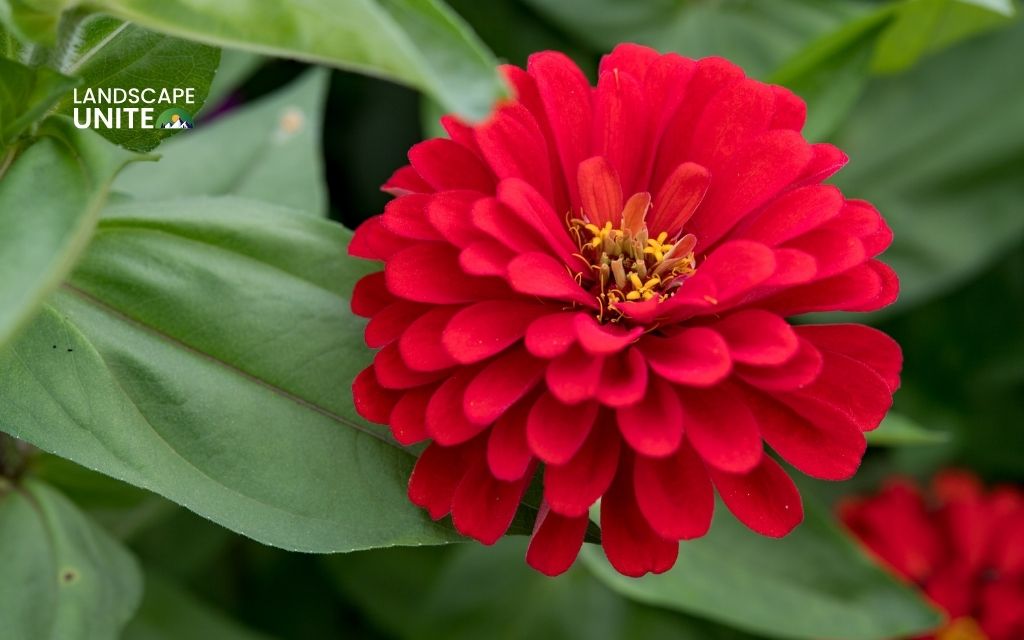
Impatiens
For shaded areas that need a pop of color, impatiens deliver cheerful red blooms all season long. These shade-tolerant annuals thrive in moist, well-drained soil and partial to full shade.
Standard impatiens work beautifully under trees and in woodland gardens, while New Guinea impatiens tolerate more sun and offer larger flowers and variegated foliage.
- Light: Partial to full shade
- Water: Keep soil consistently moist
- Mature Size: 6 – 24 in. tall, 12 – 24 in. wide
- Difficulty: Easy
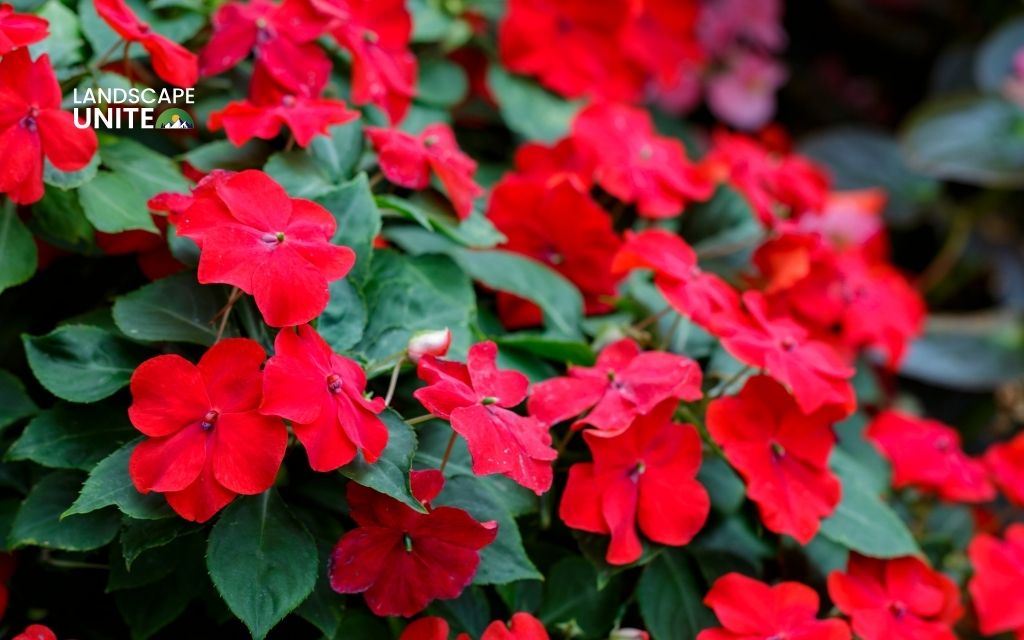
Celosia (Cockscomb)
Unique among red flowering plant options, celosia produces dramatic plume or crested flowers in fiery shades. These heat-loving annuals thrive in full sun and well-drained soil, making them ideal for southern gardens and xeriscaping.
The unusual texture of cockscomb flowers adds architectural interest to red flower garden designs, and they dry beautifully for arrangements.
- Light: Full sun
- Water: When soil surface dries out
- Mature Size: 12 – 36 in. tall, 12 – 18 in. wide
- Difficulty: Easy
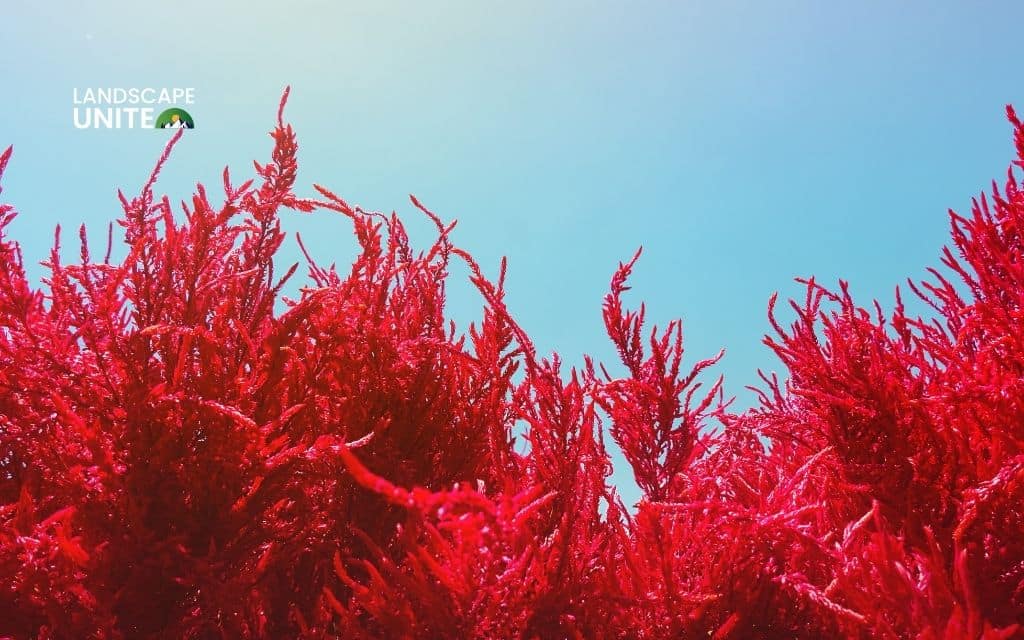
Begonia
Compact and versatile, begonias offer waxy red flowers and attractive foliage that thrives in partial shade to full sun depending on the variety.
Tuberous begonias produce large, rose-like blooms, while wax begonias are excellent for edging and mass plantings.
These plants prefer consistently moist soil and benefit from afternoon shade in hot climates.
- Light: Partial shade to full sun (variety dependent)
- Water: When top inch of soil is dry
- Mature Size: 6 – 18 in. tall, 6 – 12 in. wide
- Difficulty: Easy to Moderate
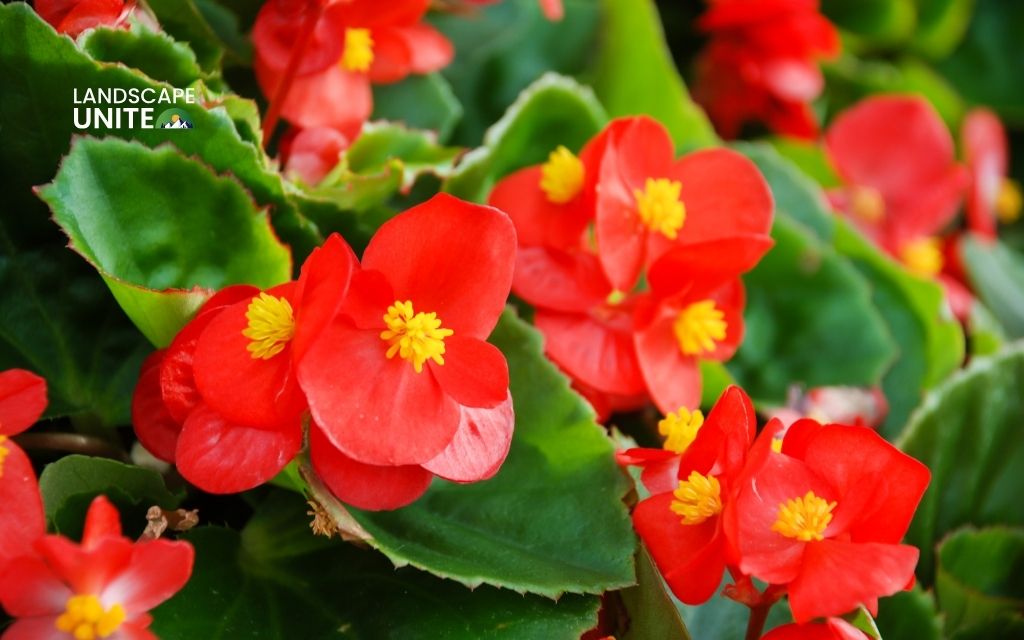
Verbena
Low-growing verbena creates carpets of clustered red blooms that attract butterflies and hummingbirds throughout the summer. These drought-tolerant plants work beautifully as groundcovers, in containers, or spilling over walls.
Plant in full sun with excellent drainage, and deadhead spent blooms to encourage continuous flowering through fall.
- Light: Full sun
- Water: When soil is dry; drought-tolerant
- Mature Size: 6 – 12 in. tall, 12 – 24 in. wide
- Difficulty: Easy
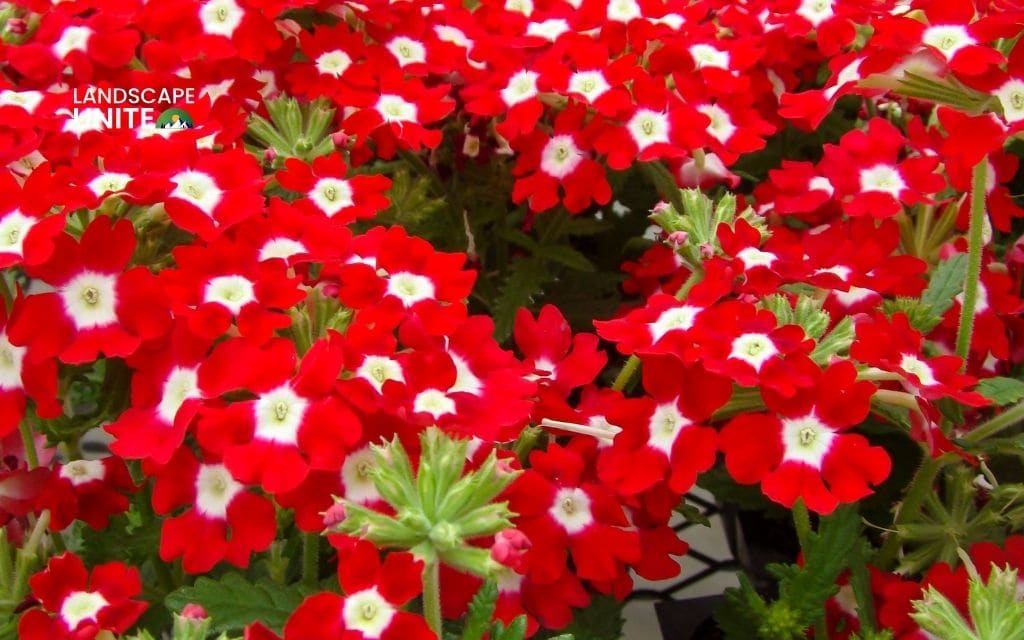
Red blooming plants: Spectacular perennials
Dahlia
Few red flowered plants rival dahlias for sheer showstopping beauty.
These tuberous perennials produce dinner-plate sized blooms in countless forms – from spiky cactus dahlias to perfectly rounded ball types. Plant tubers after the last frost in rich, well-amended soil with full sun.
Dahlias require staking for larger varieties and regular deadheading. In zones 8-11, tubers can overwinter in the ground; elsewhere, dig and store them indoors.
- Light: Full sun (6+ hours)
- Water: 2-3 times per week in hot weather
- Mature Size: 1 – 6 ft. tall, 1 – 3 ft. wide
- Difficulty: Moderate
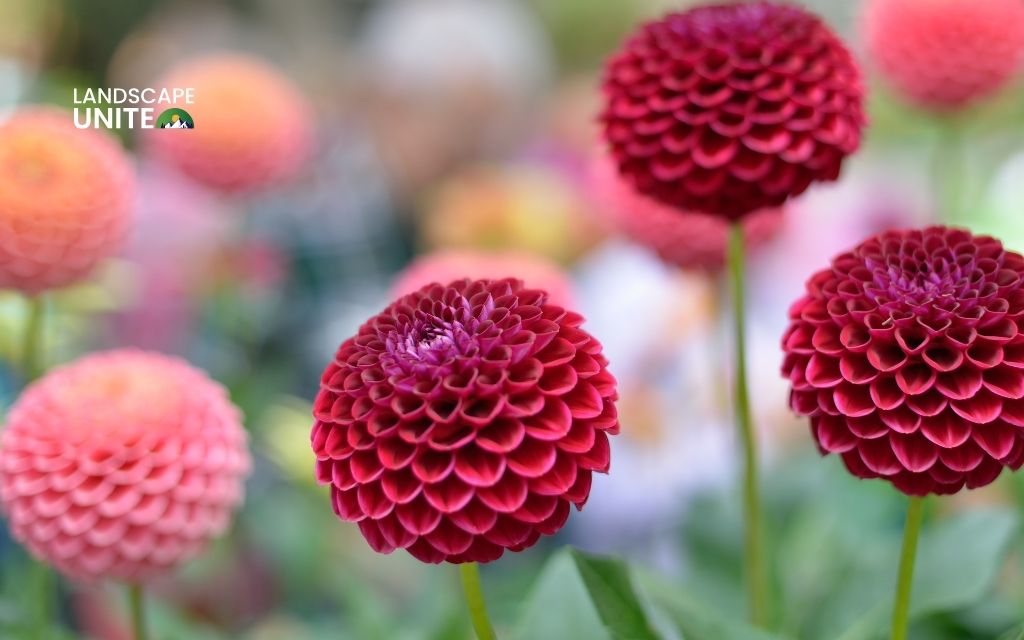
Tulip ‘Red Emperor’
Among the most striking red spring flowers, these early-season bulbs produce large, scarlet blooms that signal winter’s end.
Plant bulbs in fall, 6 – 8 inches deep in well-drained soil with full sun. Red Emperor tulips naturalize better than many hybrid varieties, returning year after year.
They pair beautifully with yellow daffodils and white hyacinths for classic spring displays.
- Light: Full sun
- Water: Moderate during growth; dry during dormancy
- Mature Size: 12 – 18 in. tall
- Difficulty: Easy
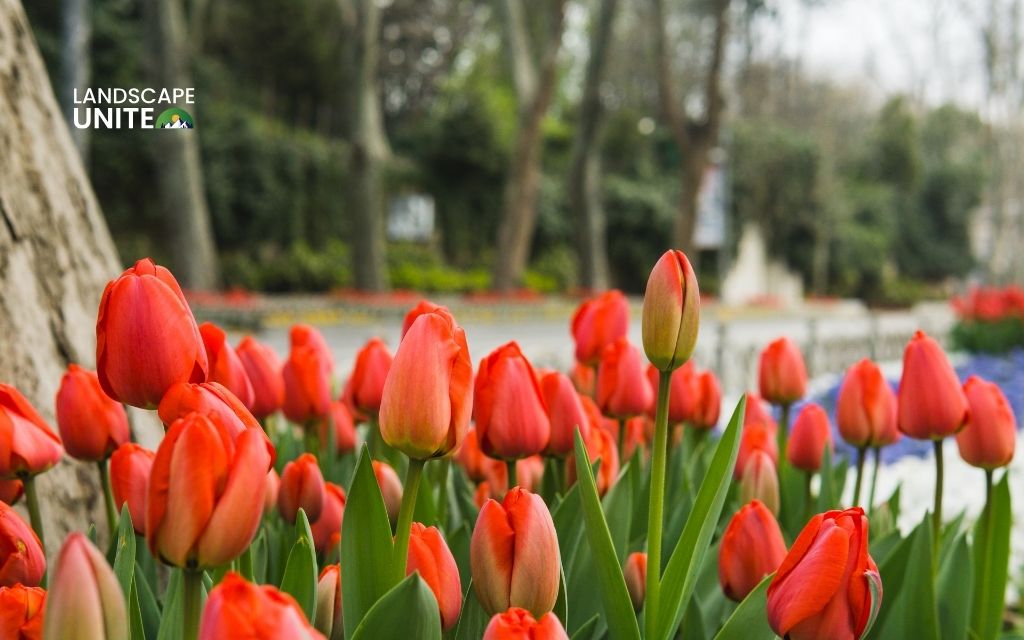
Amaryllis
These bold, trumpet-shaped red flowers create stunning indoor displays during winter months, then can be transitioned outdoors in warm climates.
Amaryllis bulbs are simple to force for holiday blooms – plant in pots with the top third of the bulb exposed, water sparingly until growth begins, then provide bright light.
In zones 9 – 11, they can be grown as garden perennials.
- Light: Bright indirect light
- Water: Sparingly until growth begins, then regularly
- Mature Size: 18 – 24 in. tall
- Difficulty: Easy
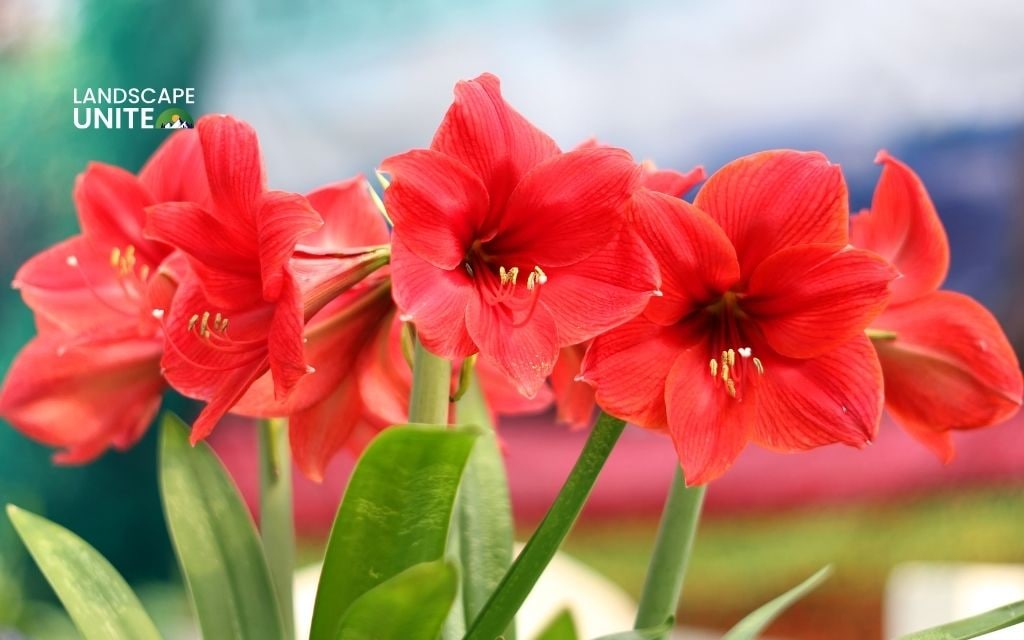
Oriental Poppy (Papaver orientale)
Oriental poppies are among the most dramatic perennial flowers red gardeners can grow. These spring bloomers produce large, papery petals with distinctive dark centers atop sturdy stems.
Plant in full sun with excellent drainage, as poppies resent wet feet. The foliage dies back after flowering, so interplant with late-emerging perennials to fill the gap.
- Light: Full sun
- Water: Moderate; avoid overwatering
- Mature Size: 24 – 36 in. tall, 18 – 24 in. wide
- Difficulty: Easy
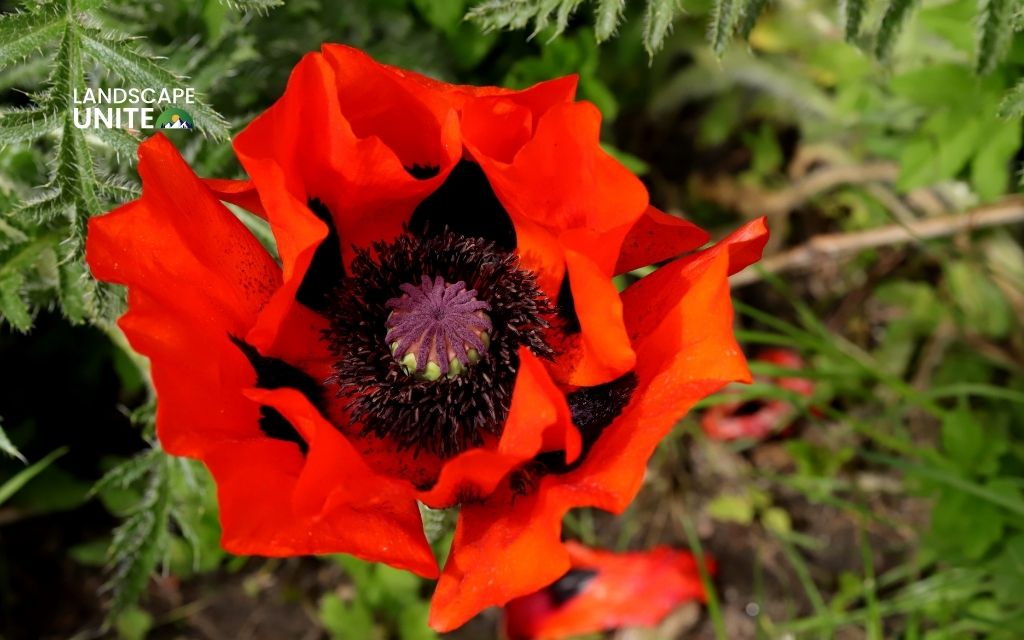
Camellia japonica
This elegant evergreen shrub offers glossy foliage year-round and produces spectacular red flowers from late fall through early spring, depending on variety. Camellias thrive in partial shade with acidic, well-drained soil rich in organic matter.
They’re hardy in zones 7 – 9 and make excellent specimen plants or hedges. Protect from harsh winter winds for best performance.
- Light: Partial shade
- Water: Keep soil consistently moist
- Mature Size: 6 – 12 ft. tall, 6 – 10 ft. wide
- Difficulty: Moderate
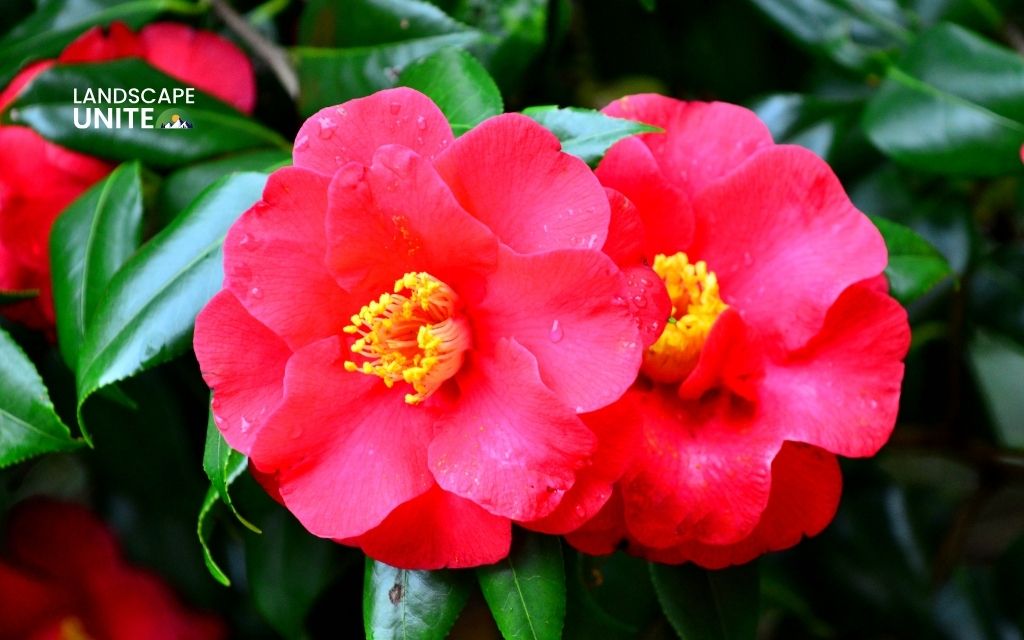
Hibiscus (Tropical Hibiscus)
These show-stopping red blooming plants feature enormous, exotic flowers that attract hummingbirds like magnets.
Tropical hibiscus thrives in full sun with consistently moist soil and benefits from regular feeding during the growing season.
Hardy in zones 9 – 11, but grown as container plants elsewhere and brought indoors for winter.
- Light: Full sun
- Water: Keep soil consistently moist
- Mature Size: 4 – 10 ft. tall, 3 – 6 ft. wide
- Difficulty: Moderate
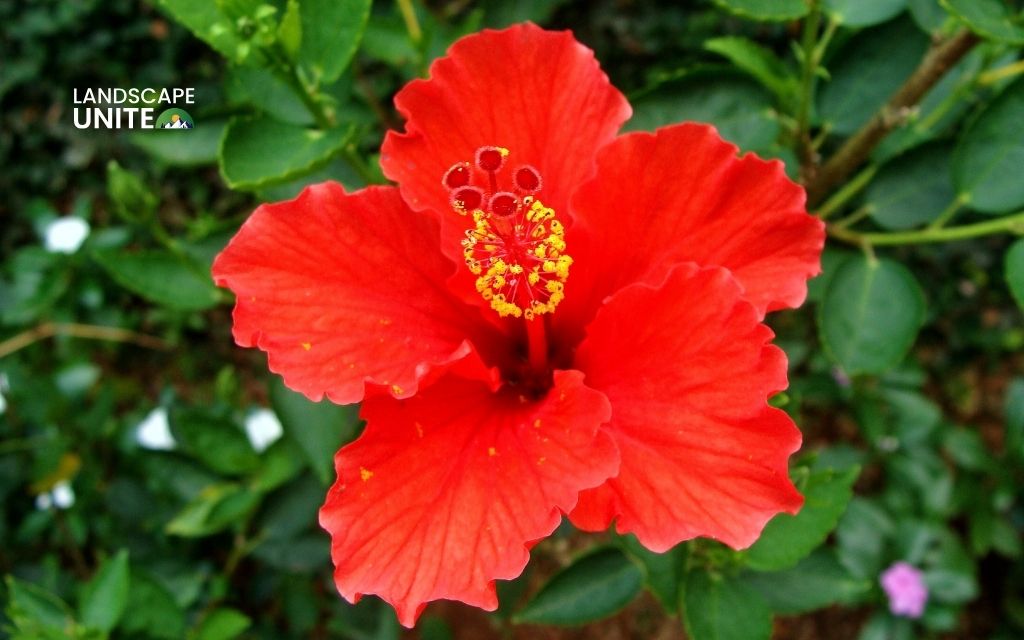
Rose (Rosa)
The classic red rose remains the gold standard among plants that are red. From climbing varieties to compact shrubs, roses offer unmatched variety and fragrance.
Modern disease-resistant cultivars like Knock Out roses require minimal care, while hybrid teas produce exhibition-quality blooms.
Plant in full sun (at least 6 hours) with well-drained, fertile soil. Roses benefit from regular fertilization and deadheading throughout the season.
- Light: Full sun (6+ hours)
- Water: Deep watering 1 – 2 times per week
- Mature Size: 2 – 8 ft. tall (variety dependent)
- Difficulty: Moderate to Needy
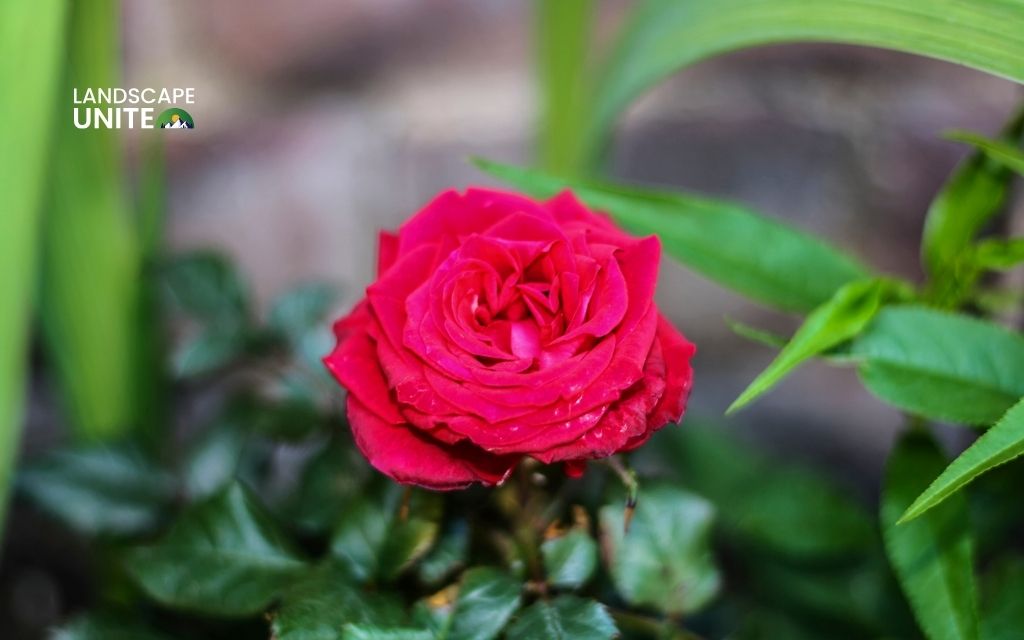
Daylily ‘Red Volunteer’
Incredibly tough and reliable, daylilies produce bold red summer flowers on sturdy stems above grass-like foliage. Each bloom lasts only one day, but plants produce dozens of buds for weeks of color.
Daylilies tolerate a wide range of conditions but prefer full sun to partial shade with consistent moisture. They’re virtually carefree and multiply readily, making them perfect for mass plantings in zones 3 – 9.
- Light: Full sun to partial shade
- Water: Weekly, drought-tolerant when established
- Mature Size: 24 – 30 in. tall, 18 – 24 in. wide
- Difficulty: Easy
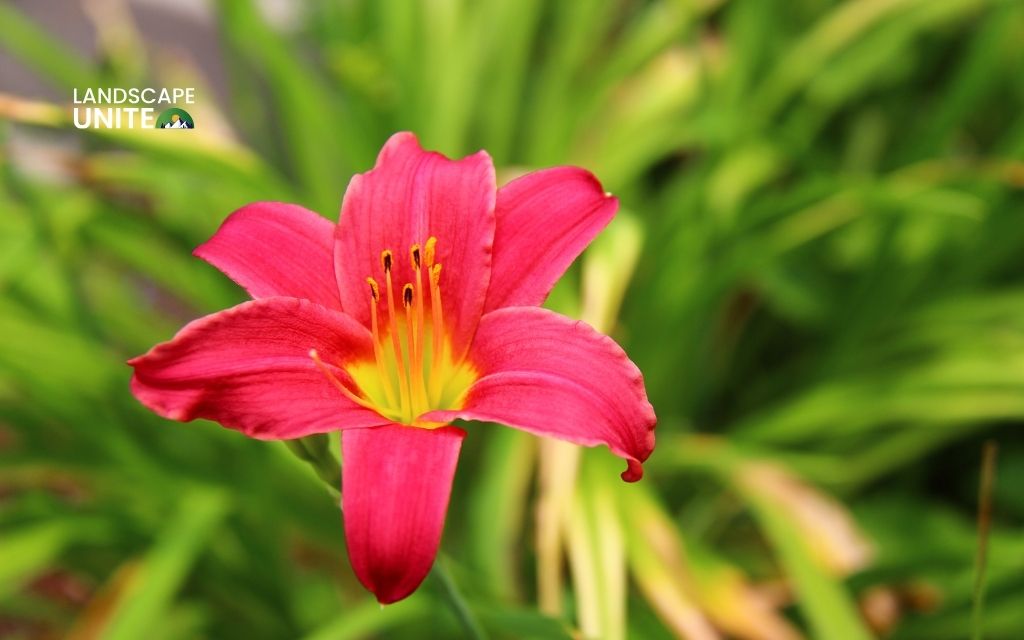
Coneflower ‘Red Ombre’ (Echinacea)
Native to North America, red echinacea varieties bring pollinator-friendly reddish flowers to the garden while requiring minimal care. These drought-tolerant perennials feature distinctive cone-shaped centers surrounded by petals that age beautifully.
- Light: Full sun
- Water: Weekly; drought-tolerant when established
- Mature Size: 24 – 30 in. tall, 18 – 24 in. wide
- Difficulty: Easy
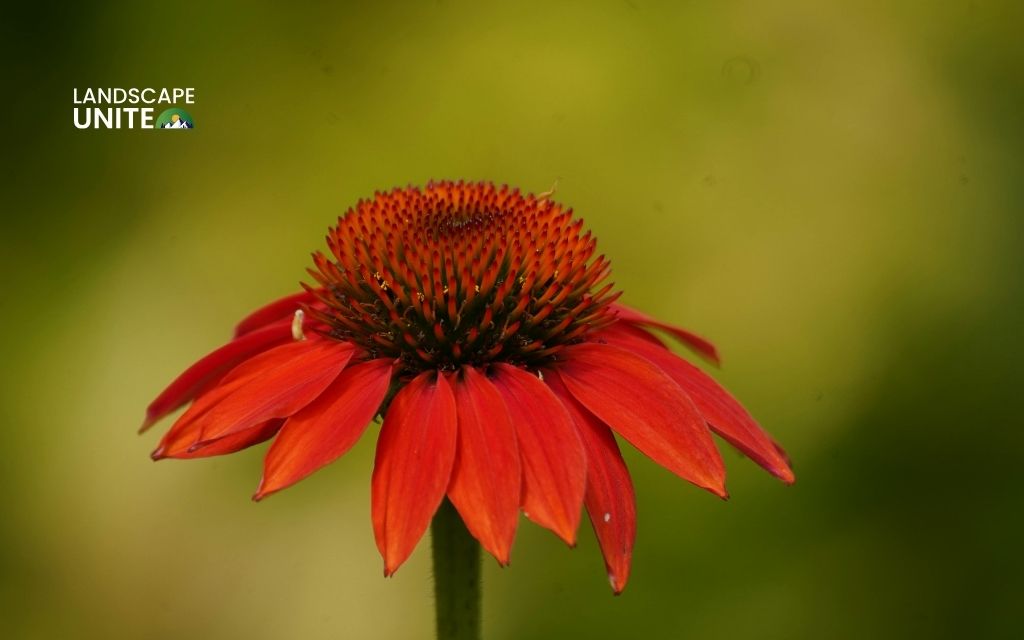
Bee Balm (Monarda ‘Jacob Cline’)
Among the best red flowering plants for attracting hummingbirds and butterflies, bee balm produces fragrant, tubular red blooms in midsummer.
This native perennial thrives in full sun to partial shade with consistent moisture. ‘Jacob Cline’ offers improved mildew resistance compared to older varieties.
- Light: Full sun to partial shade
- Water: Keep soil consistently moist
- Mature Size: 36 – 48 in. tall, 24 – 36 in. wide
- Difficulty: Easy
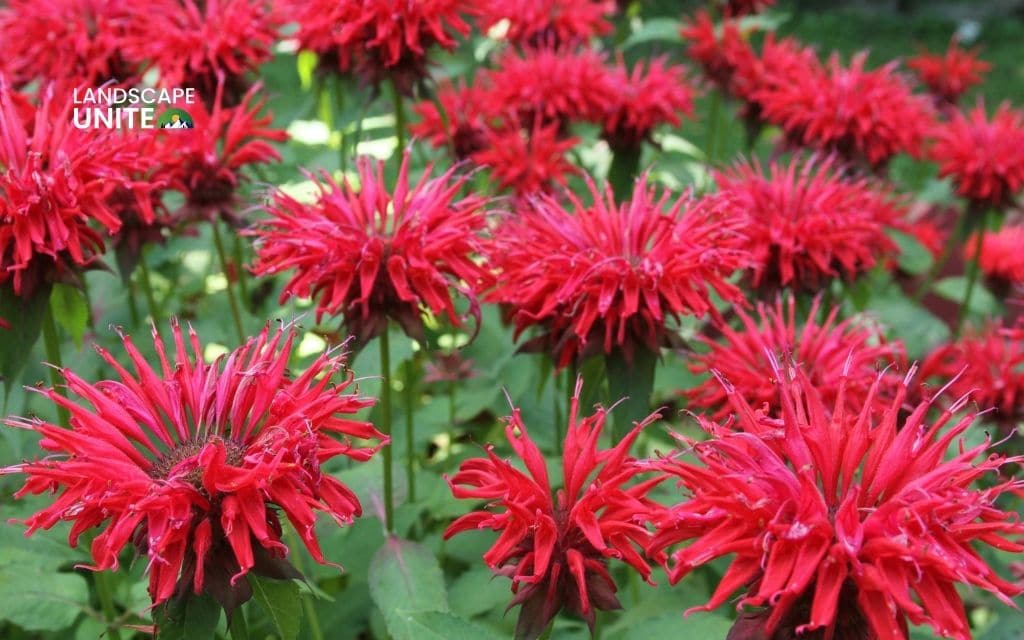
Gaillardia (Blanket Flower)
These cheerful red and yellow flowers bring prairie-style charm to gardens while tolerating heat, humidity, and drought with ease.
Blanket flowers bloom prolifically from early summer through fall, requiring only full sun and well-drained soil. Their daisy-like flowers attract butterflies and make excellent cut flowers. Hardy in zones 3-10.
- Light: Full sun
- Water: Low; drought-tolerant
- Mature Size: 12 – 24 in. tall, 12 – 18 in. wide
- Difficulty: Easy
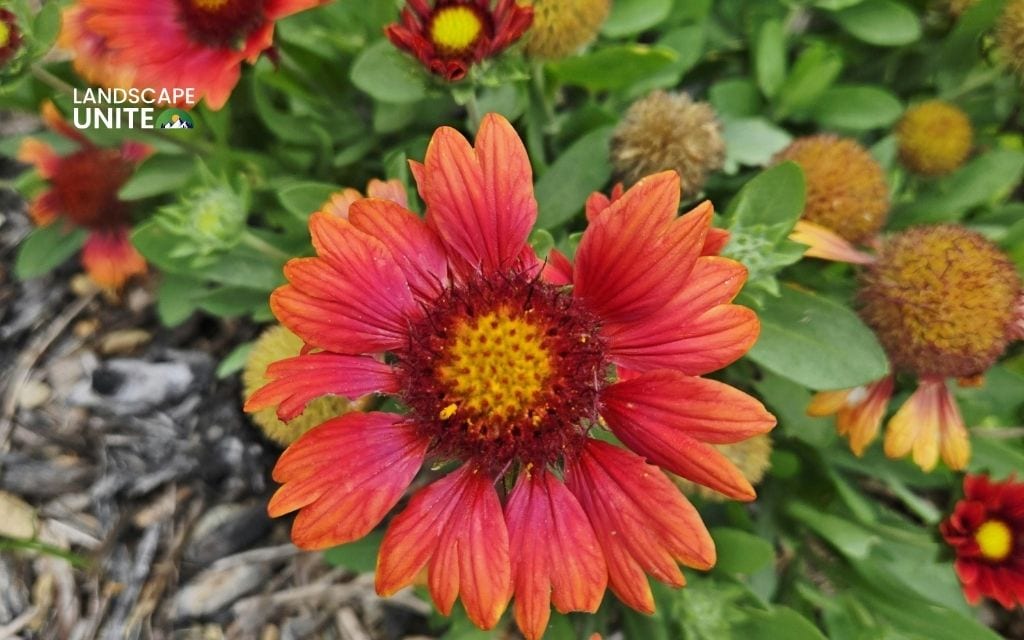
Crocosmia ‘Lucifer’
Fiery red flowers arch gracefully on tall stems in midsummer, creating spectacular vertical accents in the garden. This South African native produces sword-like foliage and multiplies into impressive clumps over time.
Plant corms in spring in full sun to partial shade with good drainage. Hardy in zones 5-9 with winter mulch in colder zones.
- Light: Full sun to partial shade
- Water: Moderate; keep moist during growth
- Mature Size: 36 – 48 in. tall, 12 – 18 in. wide
- Difficulty: Easy
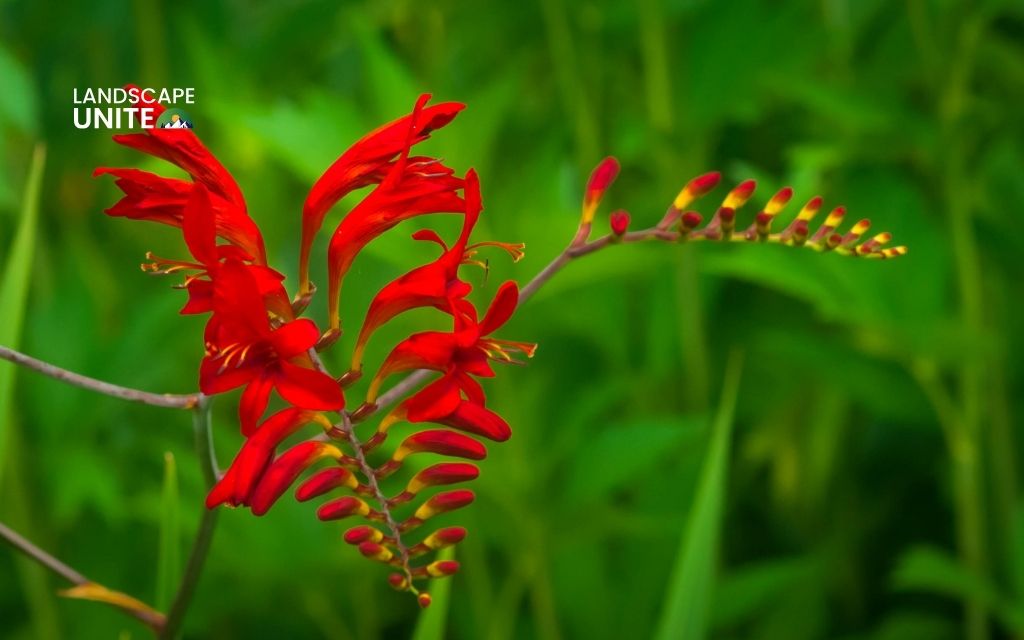
Coreopsis ‘Ruby Red’
Bright, daisy-like red flowers bloom from early summer through fall on these tough, drought-tolerant perennials. Coreopsis requires minimal care – just full sun and well-drained soil – making them perfect for low-maintenance gardens.
Deadhead for continuous blooms, and divide clumps every few years to maintain vigor. Hardy in zones 4-9.
- Light: Full sun
- Water: Low; drought-tolerant
- Mature Size: 18 – 24 in. tall, 12 – 18 in. wide
- Difficulty: Easy
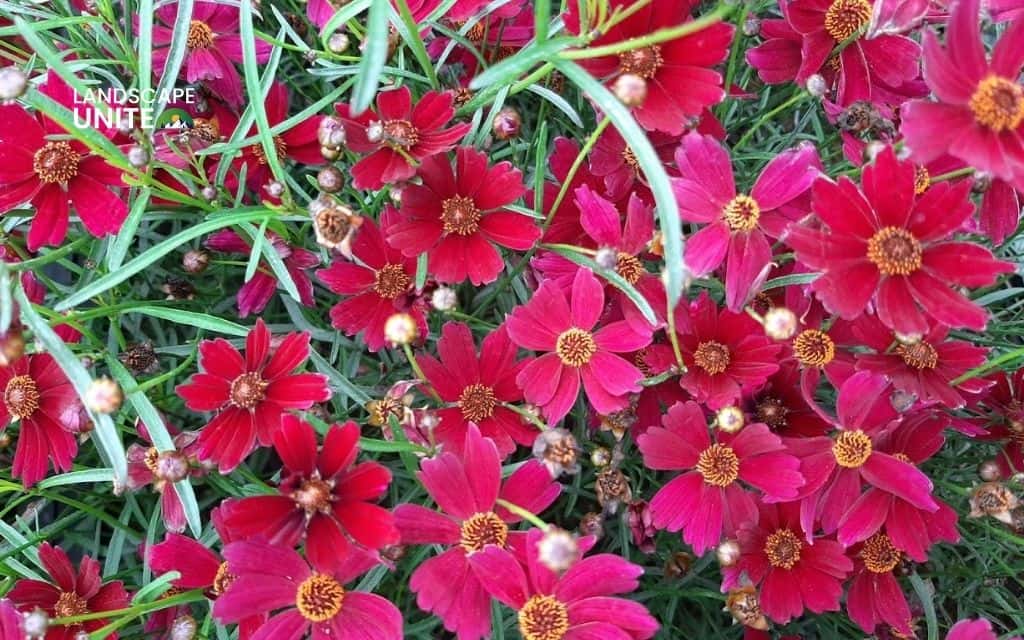
Salvia ‘Hot Lips’
These striking red blooming plants produce spikes of two-toned red and white flowers that attract hummingbirds and butterflies.
Salvias bloom from late spring through fall in full sun, tolerating heat and drought beautifully once established. They make excellent container specimens and work well in xeriscaping. Hardy in zones 6-10.
- Light: Full sun
- Water: Low to moderate; drought-tolerant
- Mature Size: 24 – 36 in. tall, 24 – 36 in. wide
- Difficulty: Easy
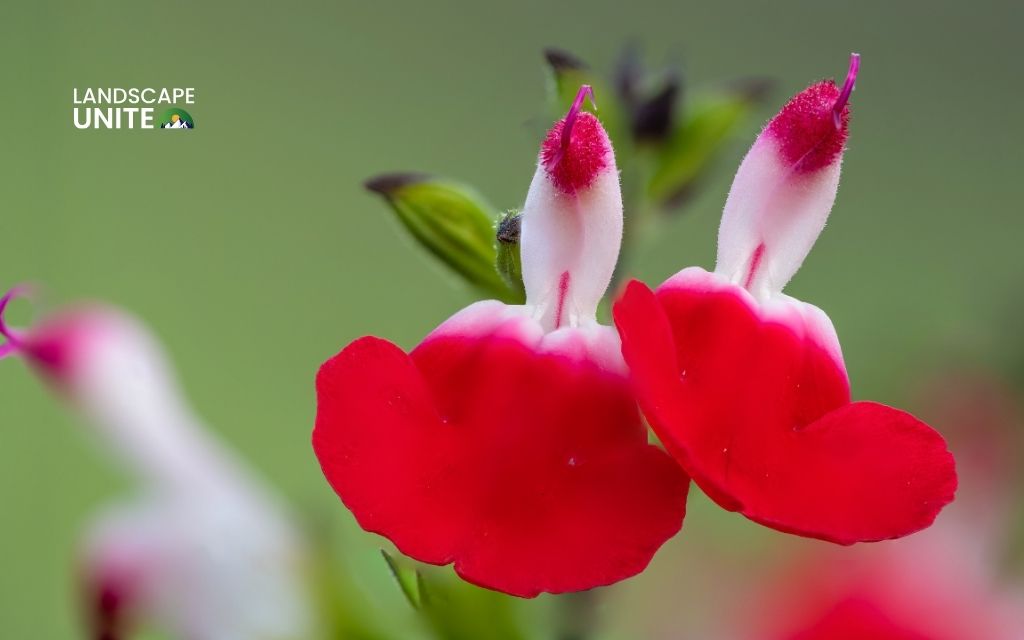
Red Hot Poker (Kniphofia uvaria)
Torch-like flower spikes in vibrant shades of red and orange create dramatic vertical elements in summer borders. These exotic-looking perennials prefer full sun and excellent drainage, particularly in winter. The grass-like foliage provides texture even when not in bloom. Hardy in zones 5-9; mulch heavily in colder zones.
- Light: Full sun
- Water: Moderate; excellent drainage required
- Mature Size: 3 – 5 ft. tall, 18 – 24 in. wide
- Difficulty: Moderate
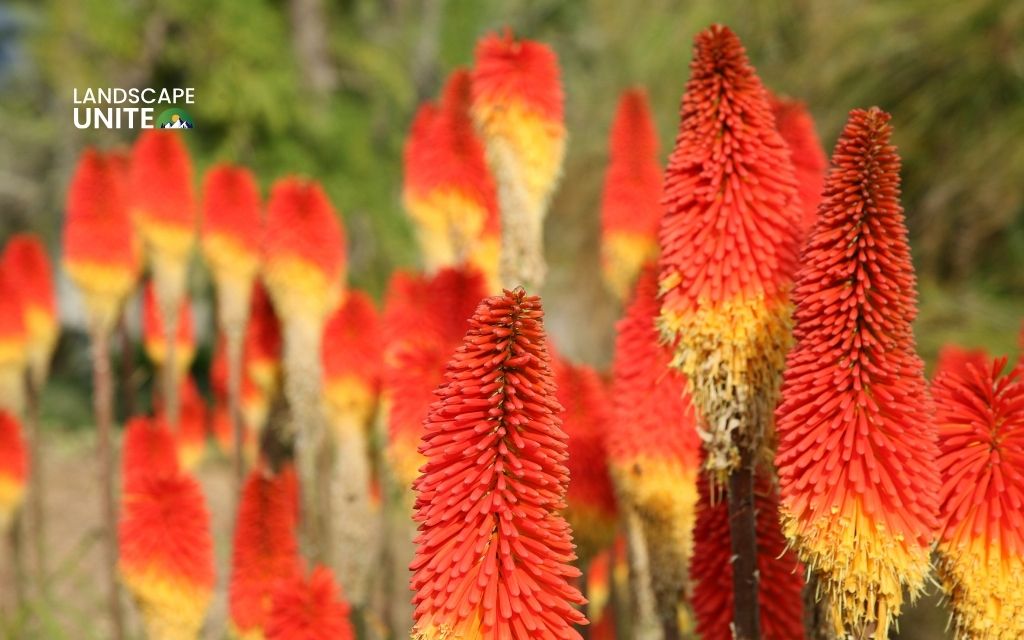
Calla Lily ‘Red Alert’
Elegant, cup-shaped red flowers rise above arrow-shaped foliage from late spring through summer. Calla lilies prefer partial shade and consistently moist (but not waterlogged) soil rich in organic matter.
Plant rhizomes in spring after frost danger passes. In zones 8-10, they can remain in the ground year-round; elsewhere, lift and store for winter.
- Light: Partial shade to full sun
- Water: Keep soil consistently moist
- Mature Size: 18 – 24 in. tall, 12 – 18 in. wide
- Difficulty: Moderate
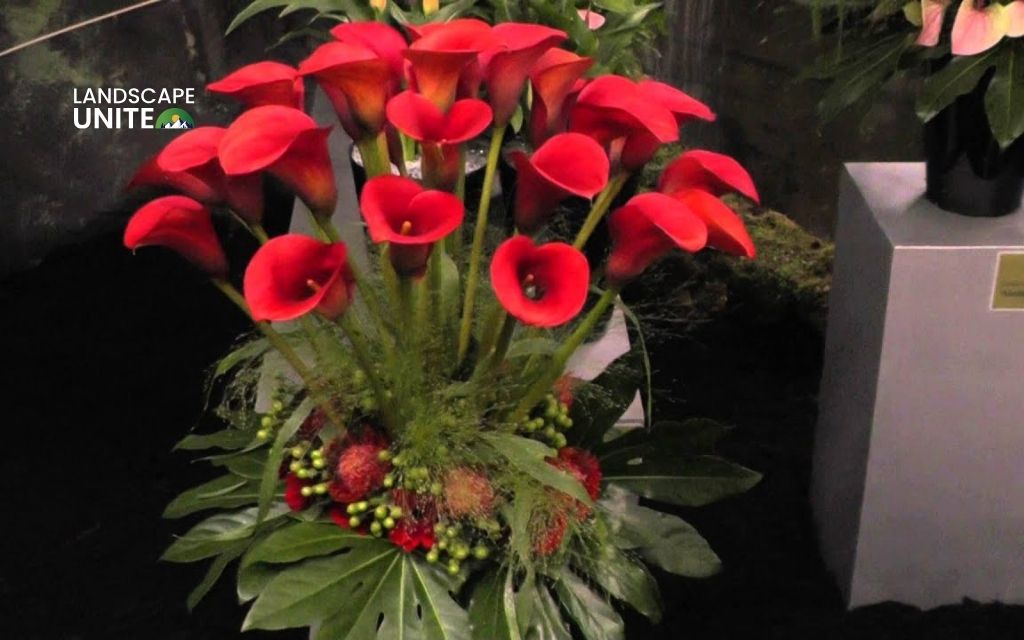
Alstroemeria ‘Inca Red’
Peruvian lilies produce clusters of long-lasting red flowers with distinctive markings, making them exceptional for cutting gardens. These vigorous perennials bloom from early summer through fall in full sun to partial shade. Plant tuberous roots in spring with good drainage, and mulch heavily in zones 7-8. Treat as annuals in colder zones.
- Light: Full sun to partial shade
- Water: Moderate; consistent moisture
- Mature Size: 24 – 36 in. tall, 18 – 24 in. wide
- Difficulty: Moderate
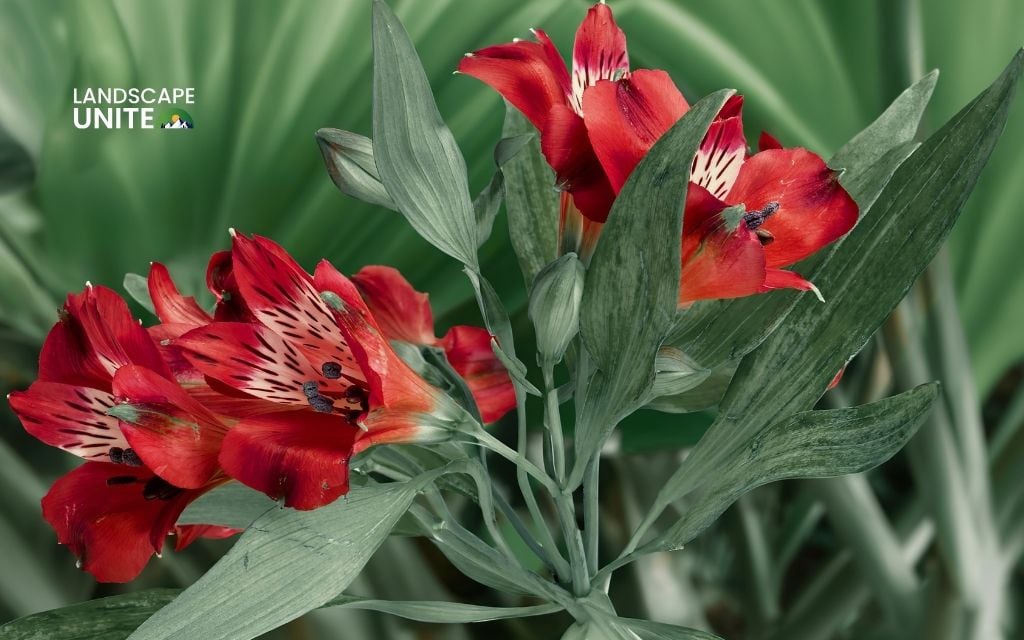
Peony ‘Red Charm’
Among the most beloved red spring flowers, peonies produce massive, double blooms with intoxicating fragrance. These long-lived perennials require patience – they may take 2 – 3 years to establish. Plant bare-root peonies in fall with eyes no more than 2 inches deep in full sun to partial shade. Hardy in zones 3-8; they require winter chill to bloom.
- Light: Full sun to partial shade
- Water: Moderate; 1 inch per week
- Mature Size: 30 – 36 in. tall, 30 – 36 in. wide
- Difficulty: Easy
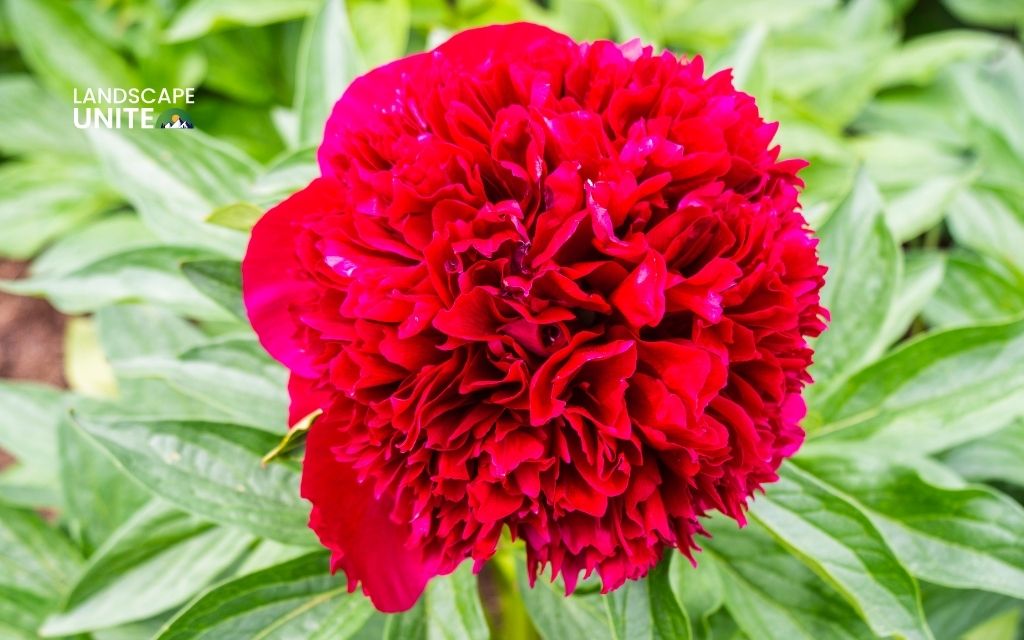
Chrysanthemum ‘Red Daisy’
Fall gardens come alive with the rich red tones of garden mums. These versatile perennials bloom from late summer through hard frost, providing essential late-season color and nectar for pollinators.
Plant in spring in full sun with well-drained soil, and pinch back regularly until midsummer for bushier plants and more blooms. Hardy in zones 5-9.
- Light: Full sun
- Water: Keep soil consistently moist
- Mature Size: 18 – 36 in. tall, 18 – 30 in. wide
- Difficulty: Easy
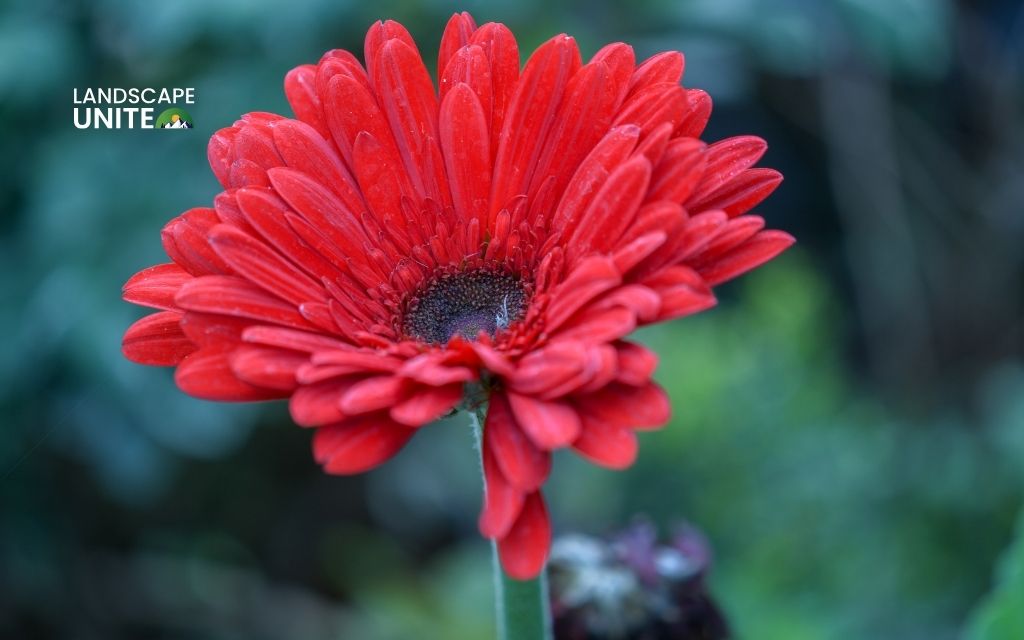
Carnation (Dianthus caryophyllus)
Fragrant and long-lasting, carnations bring old-fashioned charm and red color plants appeal to borders and cutting gardens. These cottage garden favorites thrive in full sun with alkaline, well-drained soil.
Modern varieties bloom repeatedly throughout summer with deadheading. Hardy in zones 7-10; grow as annuals elsewhere.
- Light: Full sun
- Water: Moderate; well-drained soil
- Mature Size: 12 – 24 in. tall, 9 – 12 in. wide
- Difficulty: Easy to Moderate
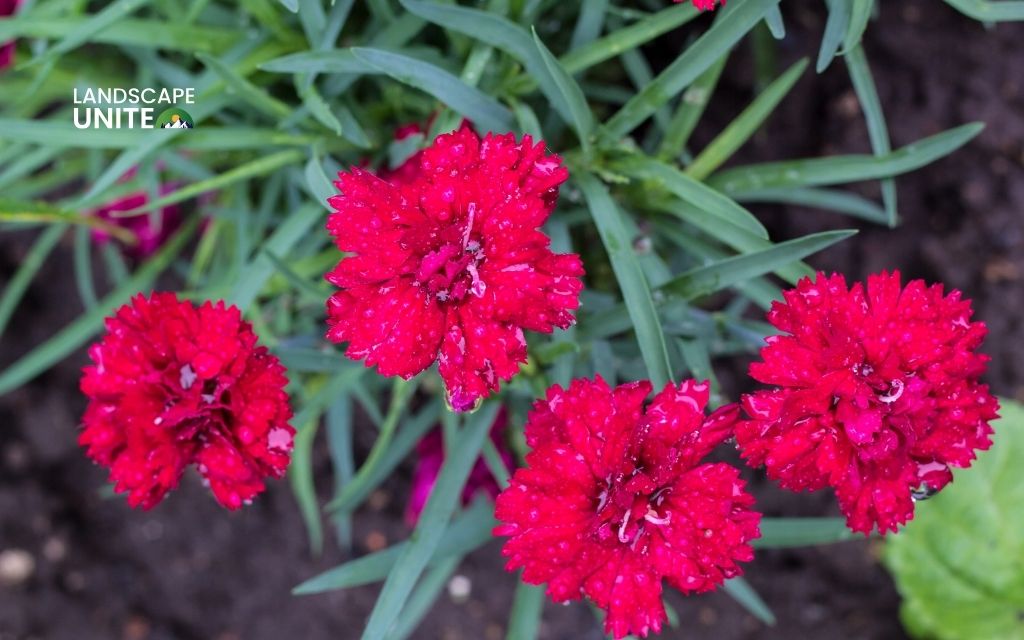
Gerbera Daisy (Gerbera jamesonii)
Bold, vibrant red flowers with prominent centers make gerbera daisies popular choices for containers and bright borders. These cheerful plants prefer full sun (with afternoon shade in hot climates) and consistent moisture. While often grown as annuals in most zones, they’re perennial in zones 9-11.
- Light: Full sun with afternoon shade
- Water: Keep soil consistently moist
- Mature Size: 12 – 18 in. tall, 12 – -18 in. wide
- Difficulty: Moderate
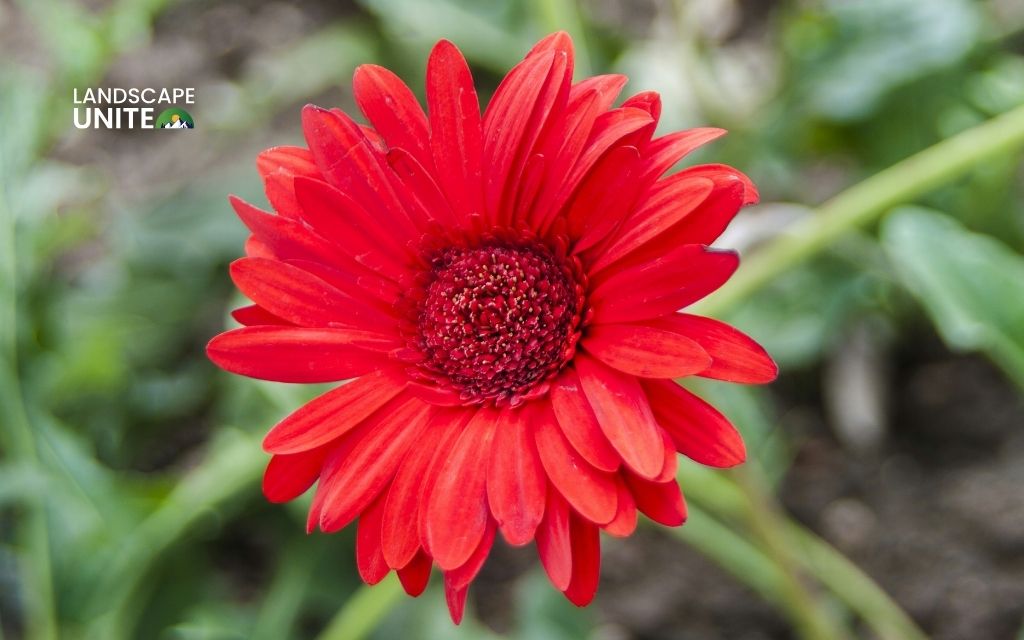
Canna Lily (Canna indica)
Tropical-looking plants with red flowers and dramatic foliage create instant jungle appeal. Cannas grow rapidly from rhizomes, reaching 3-6 feet tall depending on variety.
Plant in full sun with rich, moist soil after frost danger passes. They’re heavy feeders, benefiting from regular fertilization. Hardy in zones 8-11; dig rhizomes and store in colder zones.
- Light: Full sun
- Water: Keep soil consistently moist
- Mature Size: 3 – 6 ft. tall, 18 – 24 in. wide
- Difficulty: Easy
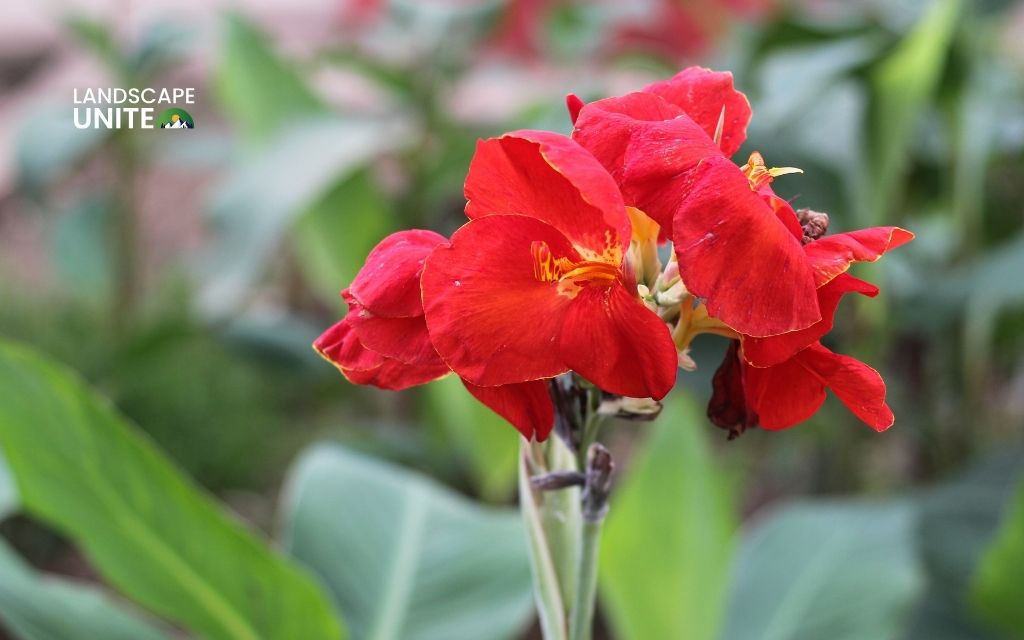
Fuchsia ‘Gartenmeister’
Unique, pendulous red flowers dangle like earrings from arching stems on these elegant plants. Fuchsias prefer partial shade and consistently moist soil, making them perfect for hanging baskets on shaded porches.
They thrive in cool summer climates and struggle in extreme heat. Hardy in zones 9-10; treat as tender perennials or annuals elsewhere.
- Light: Partial shade
- Water: Keep soil consistently moist
- Mature Size: 12 – 24 in. tall, 18 – 24 in. wide
- Difficulty: Moderate
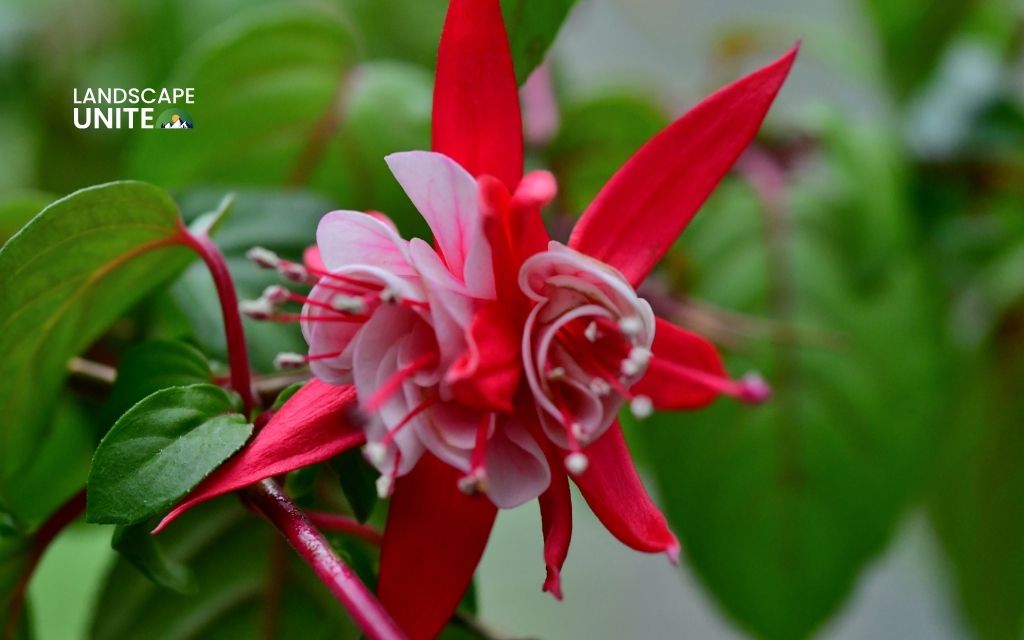
Red foliage: Stunning ornamental plants
Coleus ‘Redhead’
Ornamental foliage plants with solid red leaves create non-stop color from spring through frost without requiring any flowers. Coleus thrives in partial shade to full sun (with afternoon shade in hot climates) and moist, well-drained soil.
Pinch back regularly to encourage bushiness and prevent flowering. These heat-loving plants make excellent container specimens and bedding plants.
- Light: Partial shade to full sun
- Water: Keep soil consistently moist
- Mature Size: 18 – 24 in. tall, 12 – 18 in. wide
- Difficulty: Easy
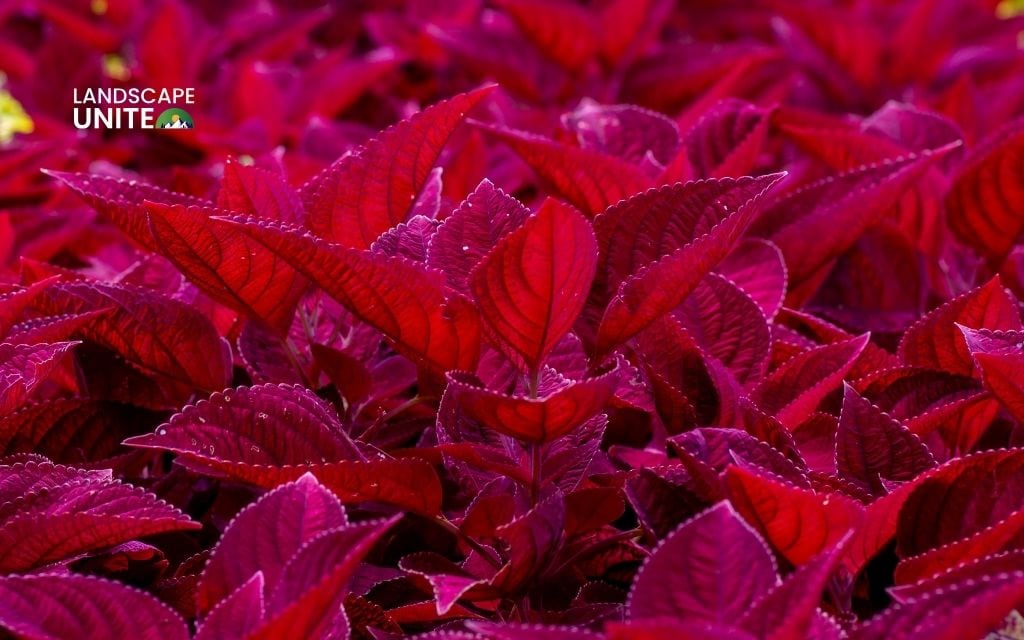
Heuchera ‘Fire Chief’ (Coral Bells)
Red-toned perennial foliage brightens shaded gardens year-round in milder climates. Coral bells form low mounds of colorful leaves topped by delicate flower spikes in late spring. They prefer partial shade and well-drained soil rich in organic matter. Hardy in zones 4-9, heucheras are semi-evergreen in warmer zones and provide winter interest.
- Light: Partial shade to full sun
- Water: Moderate; well-drained soil
- Mature Size: 8 – 12 in. tall, 12 – 18 in. wide
- Difficulty: Easy
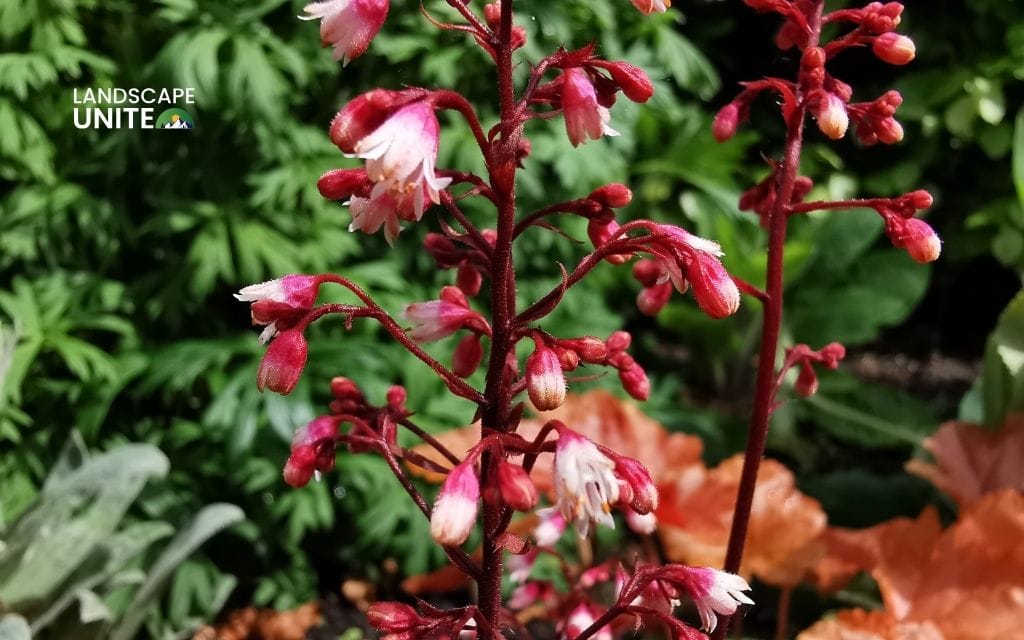
Japanese Maple (Acer palmatum ‘Bloodgood’)
This stunning small tree displays deep red leaves from spring through fall, making it one of the most sought-after plants that are red.
Japanese maples prefer partial shade (especially afternoon shade) and well-drained, slightly acidic soil. They grow slowly but create elegant, architectural focal points in the landscape. Hardy in zones 5-8; protect from harsh winds.
- Light: Partial shade
- Water: Regular watering; keep moist
- Mature Size: 15 – 25 ft. tall, 15 – 20 ft. wide
- Difficulty: Moderate
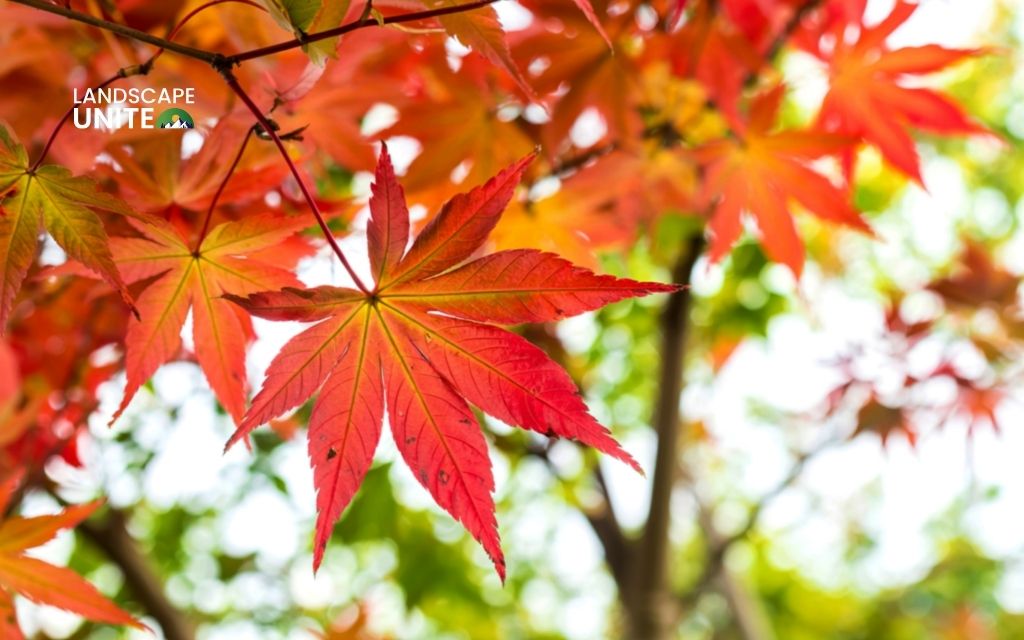
Smoke Bush (Cotinus coggygria ‘Royal Purple’)
Large shrubs with reddish-purple foliage create dramatic backdrops in mixed borders. In midsummer, plants produce airy, smoke-like plumes of flowers that add to their ornamental appeal.
Smoke bush thrives in full sun with well-drained soil and tolerates drought once established. Hardy in zones 5-9; can be pruned hard in early spring for the most vibrant foliage.
- Light: Full sun
- Water: Low to moderate; drought-tolerant
- Mature Size: 10 – 15 ft. tall, 10 – 15 ft. wide
- Difficulty: Easy
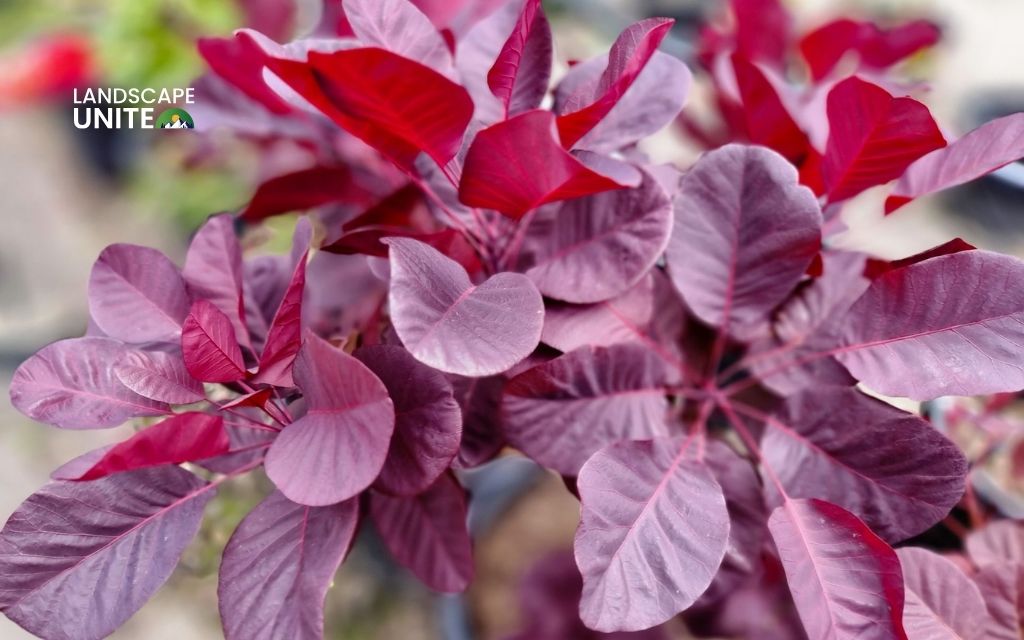
Ti Plant (Cordyline fruticosa)
Tropical plants with bold red and pink foliage bring exotic flair to containers and warm-climate landscapes. Ti plants prefer partial shade and consistently moist soil. In zones 10-11, they can reach 6-10 feet tall; elsewhere, grow as houseplants or summer annuals. They make spectacular poolside or patio specimens.
- Light: Partial shade to full sun
- Water: Keep soil consistently moist
- Mature Size: 6 – 10 ft. tall, 3 – 4 ft. wide
- Difficulty: Moderate
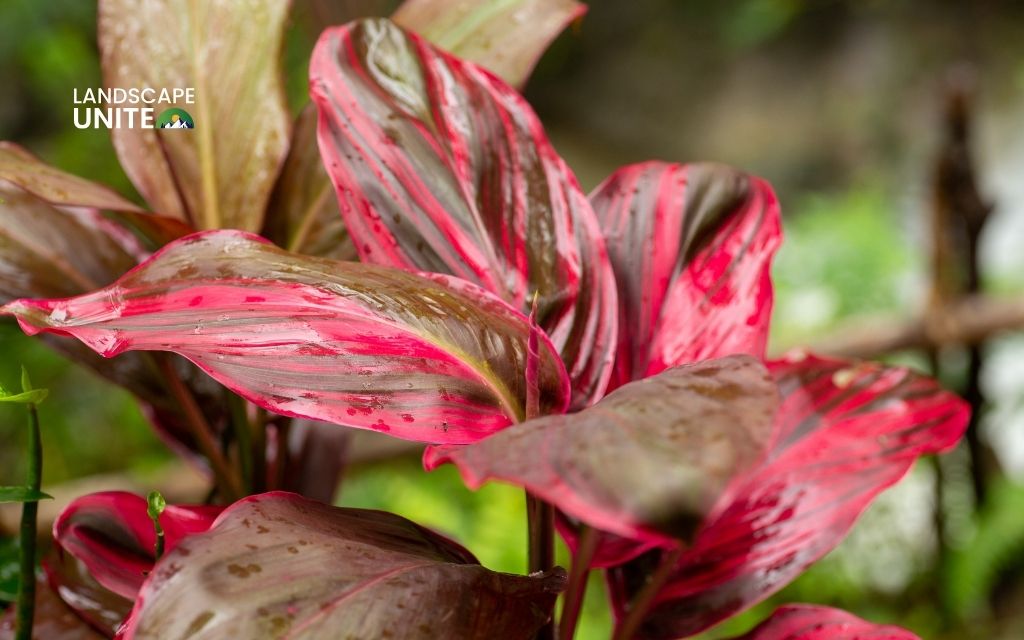
Croton ‘Mammy’
These houseplants with vibrant red, orange, and yellow leaves add tropical color indoors. Crotons require bright, indirect light and warm temperatures (never below 60°F).
Keep soil consistently moist and provide high humidity for the best color. They’re sensitive to drafts and temperature fluctuations, so choose their location carefully.
- Light: Bright indirect light
- Water: Keep soil consistently moist
- Mature Size: 3 – 6 ft. tall, 2 – 3 ft. wide
- Difficulty: Needy
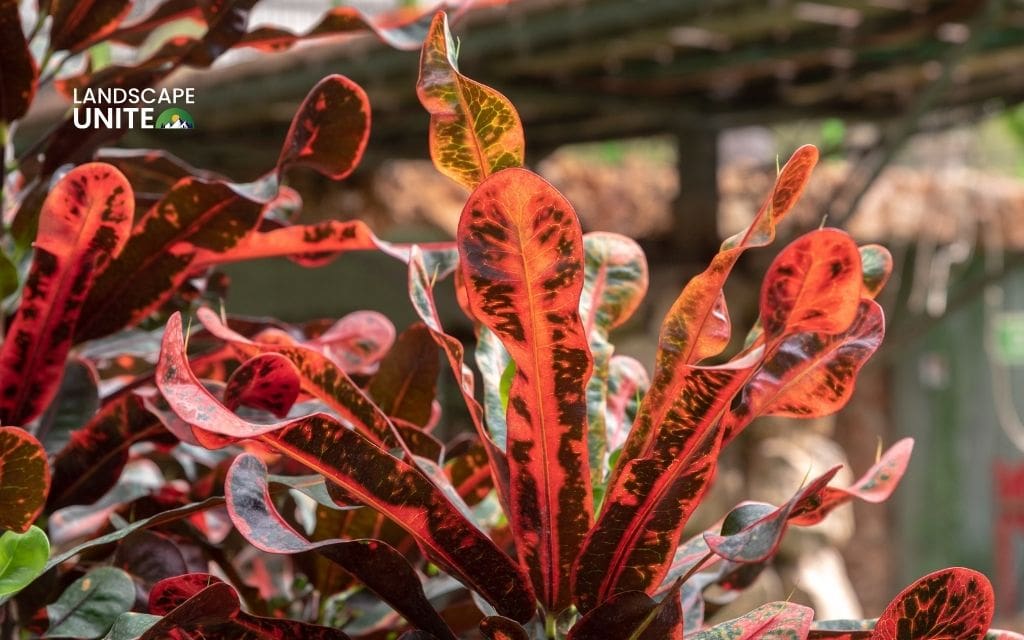
Nandina domestica (Heavenly Bamboo)
Evergreen shrubs with red fall foliage and bright berries provide four-season interest. Despite the common name, nandinas aren’t true bamboos but form upright, bamboo-like clumps.
They thrive in full sun to partial shade with well-drained soil. New spring growth emerges bronze-red, turns green in summer, then blazes red again in fall. Hardy in zones 6-9.
- Light: Full sun to partial shade
- Water: Moderate; drought-tolerant when established
- Mature Size: 4 – 8 ft. tall, 2 – 4 ft. wide
- Difficulty: Easy
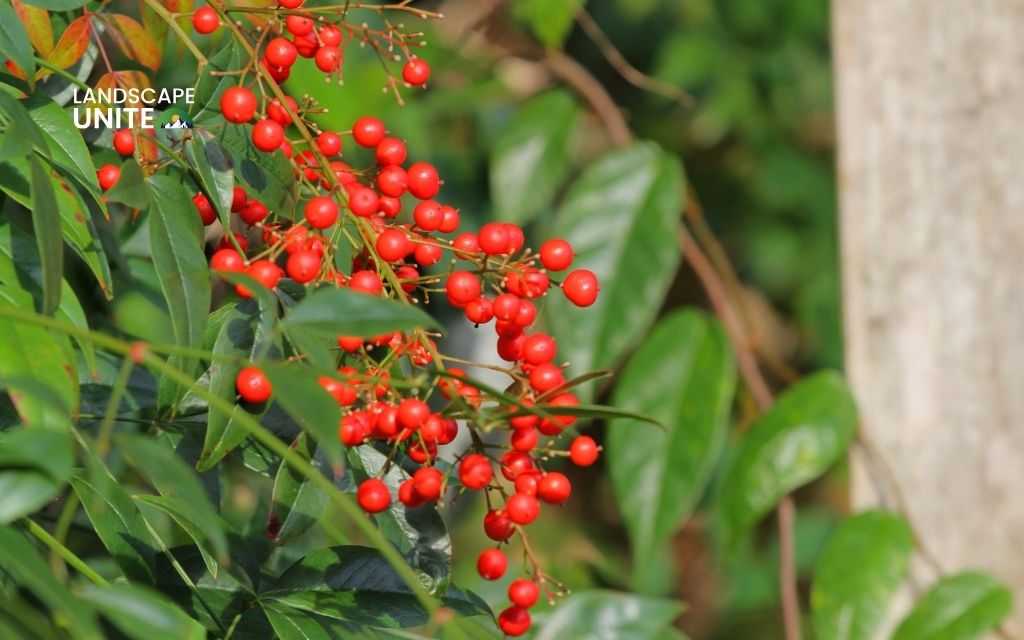
Red Fountain Grass (Pennisetum setaceum ‘Rubrum’)
Ornamental grasses with burgundy-red blades add movement and texture to gardens. These dramatic plants produce fuzzy, purple-red plumes in late summer that sway beautifully in the breeze.
Plant in full sun with well-drained soil. Hardy only in zones 9-10; grown as annuals elsewhere, but they self-seed readily in warm climates.
- Light: Full sun
- Water: Moderate; drought-tolerant when established
- Mature Size: 3 – 5 ft. tall, 2 – 4 ft. wide
- Difficulty: Easy
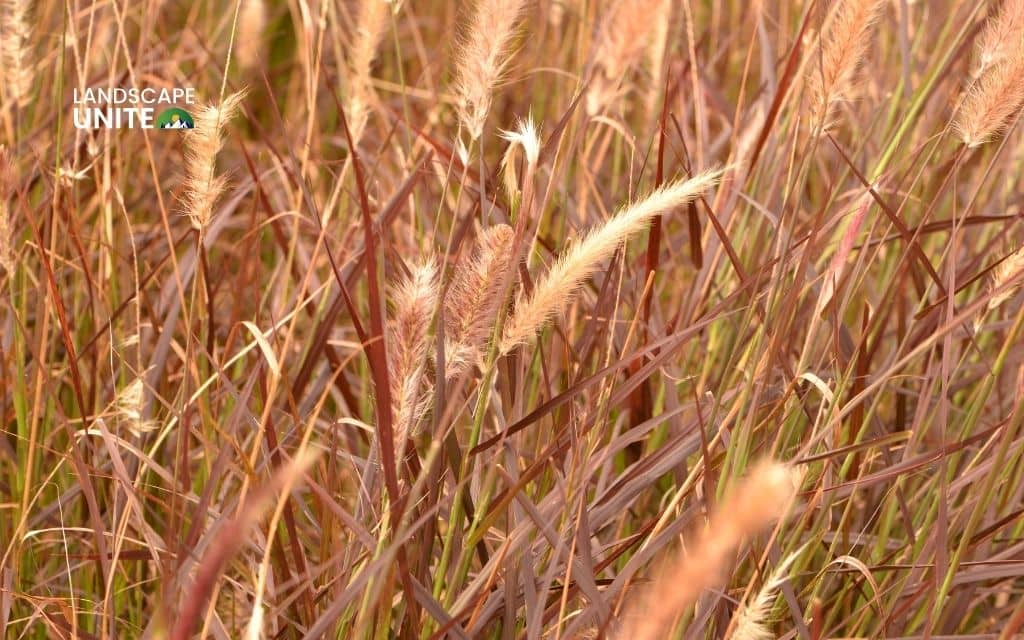
Coleus ‘Kong Red’
Large-leaved varieties with deep red centers and contrasting edges create bold statements in containers and beds.
‘Kong’ coleus tolerate more sun than traditional varieties, though they still prefer some afternoon shade in hot climates. These vigorous plants can reach 2 feet tall and wide in a single season with regular pinching and feeding.
- Light: Partial shade to sun
- Water: Keep soil consistently moist
- Mature Size: 18 – 24 in. tall, 18 – 24 in. wide
- Difficulty: Easy
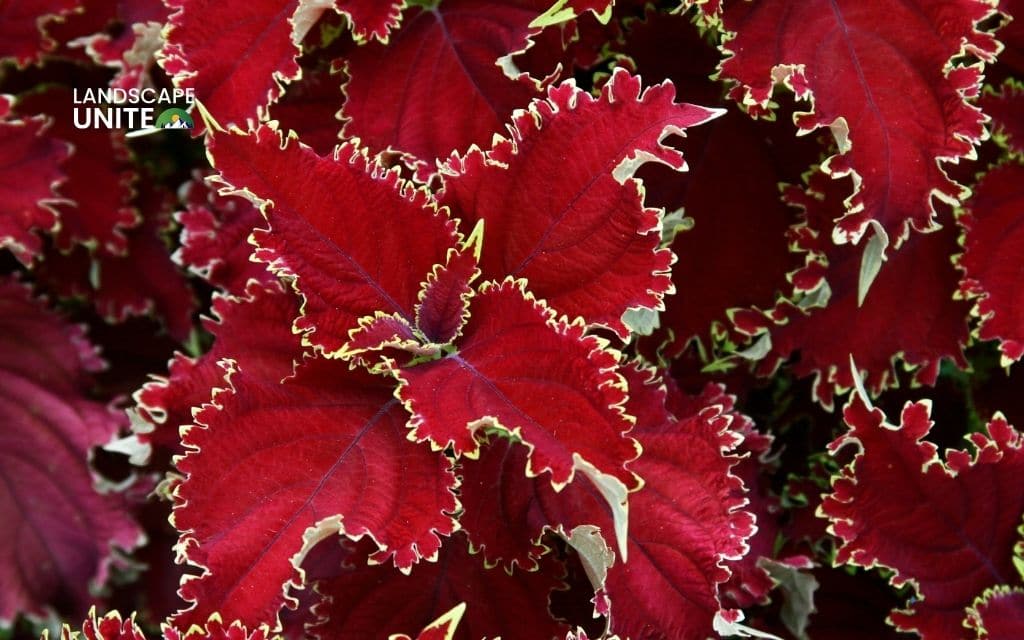
Photinia ‘Red Robin’
Shrubs with bright red new growth create hedges that look perpetually in bloom. The scarlet young leaves gradually mature to glossy green, and regular pruning encourages fresh flushes of red growth. Photinia thrives in full sun to partial shade with well-drained soil. Hardy in zones 7-9; it makes an excellent privacy screen or specimen plant.
- Light: Full sun to partial shade
- Water: Moderate; regular watering
- Mature Size: 10 – 15 ft. tall, 8 – 10 ft. wide
- Difficulty: Easy
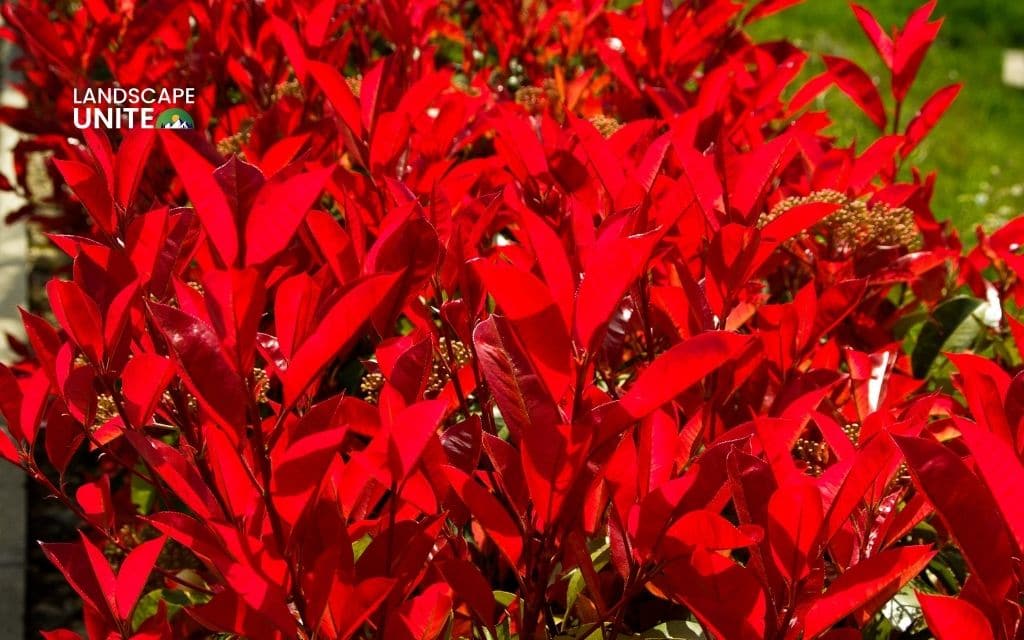
Ixora coccinea (Jungle Geranium)
Tropical shrubs with clusters of small red flowers bloom year-round in warm climates. Ixora prefers full sun to partial shade, acidic soil, and consistent moisture. These compact plants work beautifully in containers, as foundation plantings, or as low hedges. Hardy only in zones 10-11; grow as houseplants elsewhere with bright light.
- Light: Full sun to partial shade
- Water: Keep soil consistently moist
- Mature Size: 4 – 6 ft. tall, 3 – 4 ft. wide
- Difficulty: Moderate
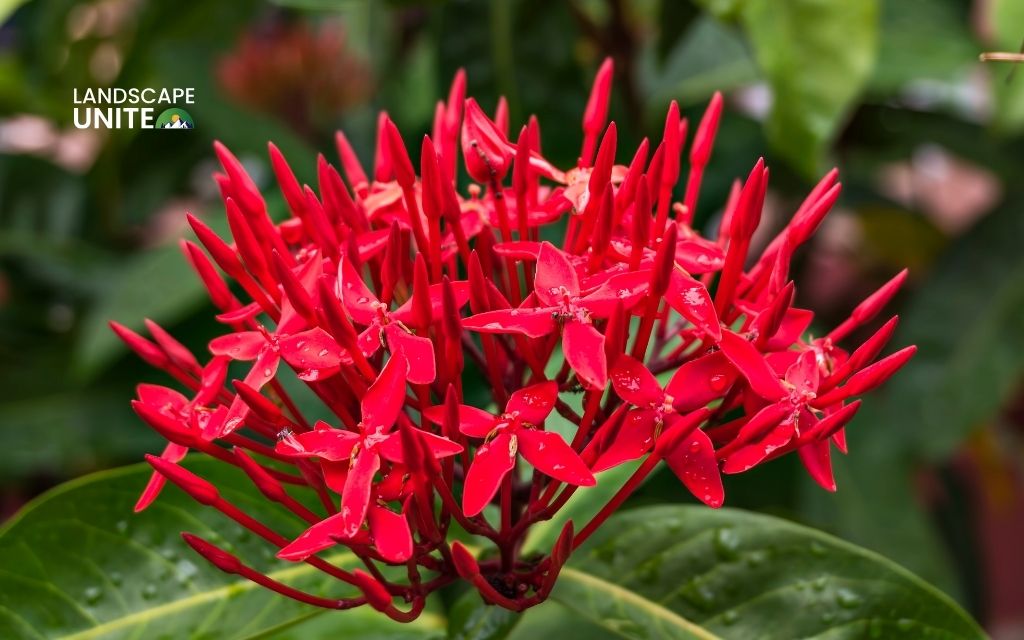
Red flowering trees and vines
Bougainvillea ‘Scarlet O’Hara’
Vigorous climbers with vibrant red bracts (modified leaves) create spectacular displays in warm climates. What appear to be flowers are actually colorful bracts surrounding tiny white true flowers.
Bougainvillea thrives in full sun with well-drained soil and tolerates drought once established. Hardy in zones 9-11; it can be grown in containers and overwintered indoors in colder zones.
- Light: Full sun
- Water: Low to moderate; drought-tolerant
- Mature Size: 15 – 30 ft. long, 3 – 6 ft. wide
- Difficulty: Moderate
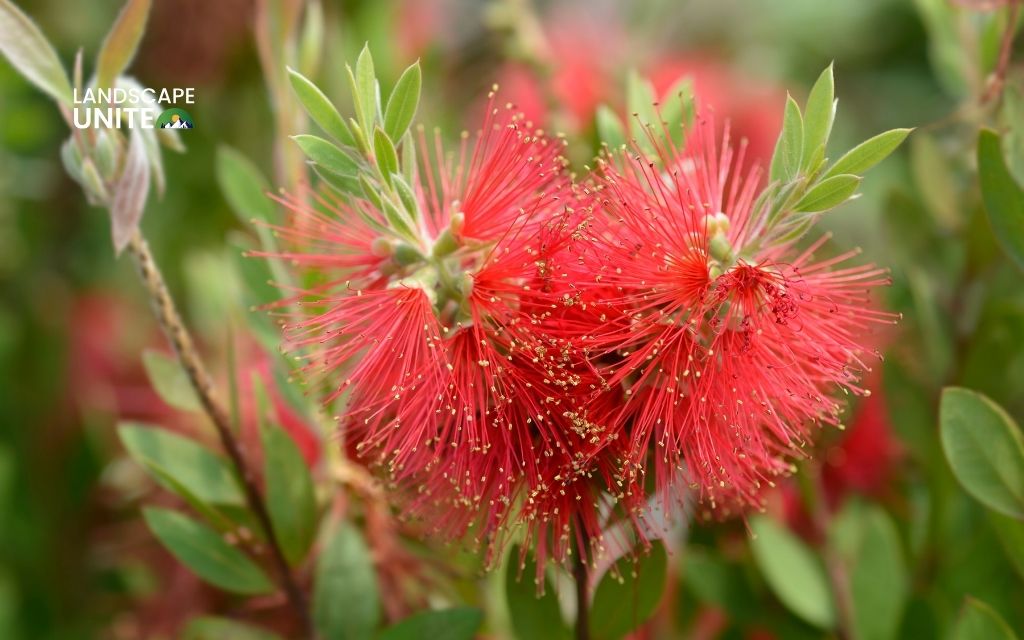
Poinsettia (Euphorbia pulcherrima)
Holiday favorites with red bracts brighten homes during winter months. While commonly treated as temporary decorations, poinsettias are actually shrubby perennials in zones 10-11. Indoors, they require bright, indirect light and should be kept away from drafts. To rebloom, they need 14 hours of complete darkness nightly for 6-8 weeks starting in October.
- Light: Bright indirect light
- Water: When soil surface is dry
- Mature Size: 3-10 ft. tall (outdoors), 12-24 in. (indoors)
- Difficulty: Moderate to Needy
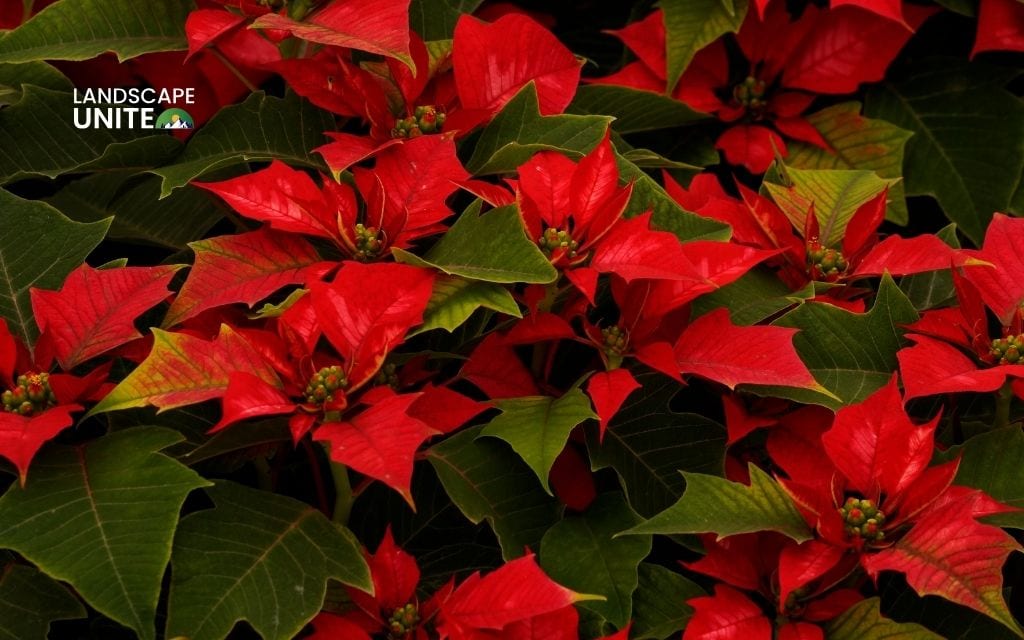
Redbud Tree (Cercis canadensis ‘Forest Pansy’)
Ornamental trees with reddish-purple foliage and spring flowers create multi-season interest. In early spring before leaves emerge, branches are covered in small, pea-like pink flowers.
The heart-shaped leaves emerge red-purple and mature to deep purple, providing color all season. Hardy in zones 5-9; plant in full sun to partial shade.
- Light: Full sun to partial shade
- Water: Moderate; drought-tolerant when established
- Mature Size: 20 – 30 ft. tall, 25 – 35 ft. wide
- Difficulty: Easy
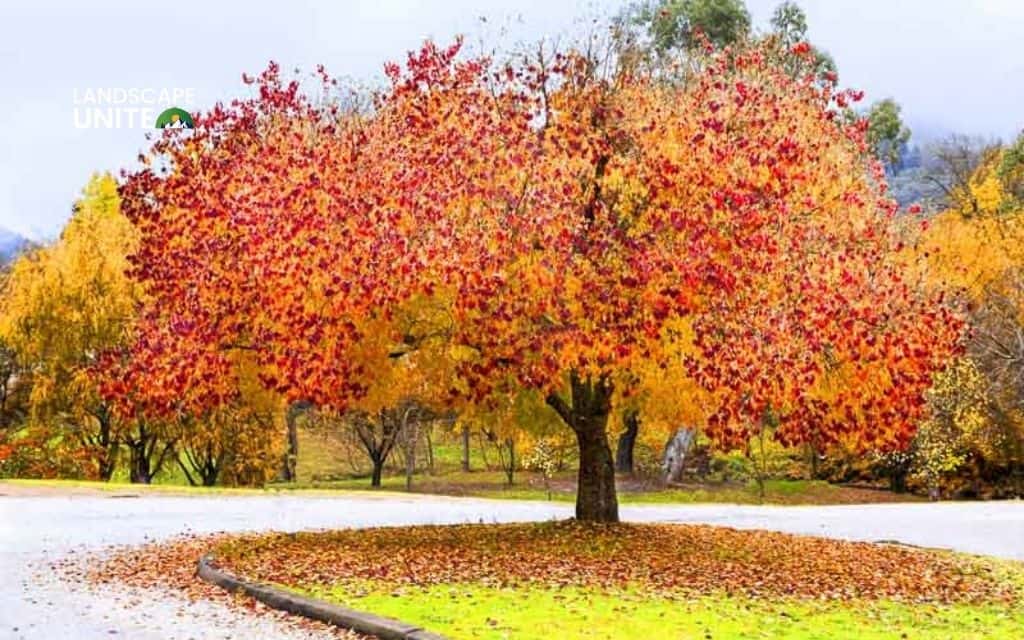
Crabapple Tree (Malus ‘Royalty’)
These small trees produce masses of red spring flowers followed by dark purple foliage and ornamental fruit. Crabapples are among the most rewarding red flowering plants for four-season interest. They prefer full sun and well-drained soil. Modern disease-resistant varieties require minimal care. Hardy in zones 4-8; the small fruits attract birds in fall.
- Light: Full sun
- Water: Moderate; weekly during dry spells
- Mature Size: 15 – 20 ft. tall, 15 – 20 ft. wide
- Difficulty: Easy
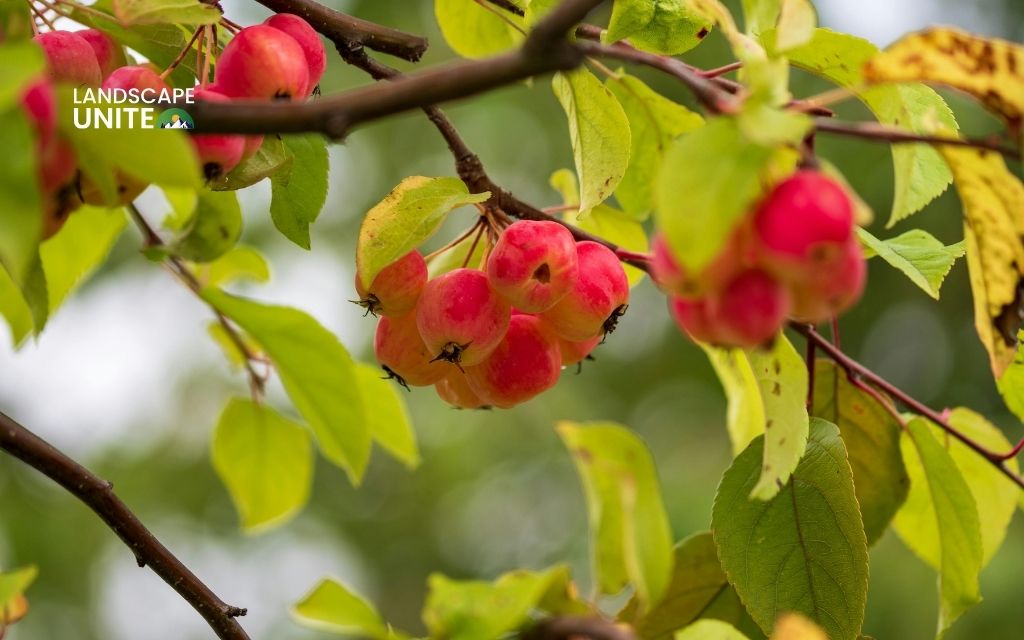
Dogwood ‘Cherokee Brave’
Trees with pinkish-red spring blossoms create stunning seasonal displays. The large, showy bracts surround tiny true flowers and can last for weeks.
Dogwoods prefer partial shade (especially afternoon shade) and moist, well-drained, acidic soil rich in organic matter. Hardy in zones 5-9; they also offer attractive fall color and winter interest.
- Light: Partial shade
- Water: Keep soil consistently moist
- Mature Size: 20 – 30 ft. tall, 20 – 30 ft. wide
- Difficulty: Moderate
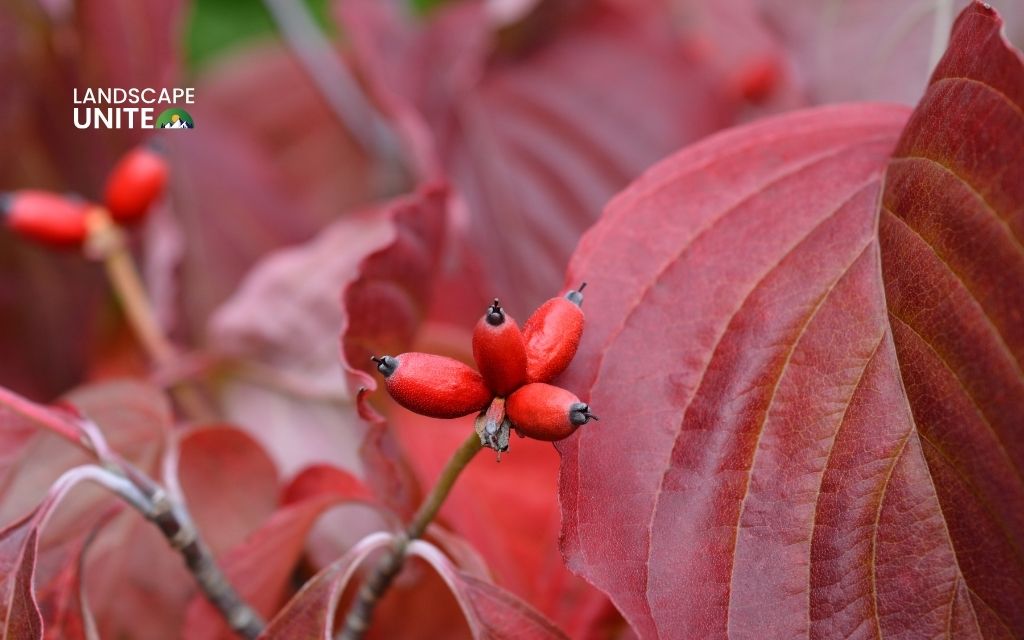
Bottlebrush Tree (Callistemon citrinus)
Australian natives with distinctive red brush-like flowers bloom in spring and sporadically throughout the year. The cylindrical flower spikes resemble bottle brushes and attract hummingbirds.
Bottlebrush trees thrive in full sun with well-drained soil and tolerate drought, salt spray, and poor soil once established. Hardy in zones 9-11.
- Light: Full sun
- Water: Low to moderate; drought-tolerant
- Mature Size: 10 – 15 ft. tall, 8 – 12 ft. wide
- Difficulty: Easy
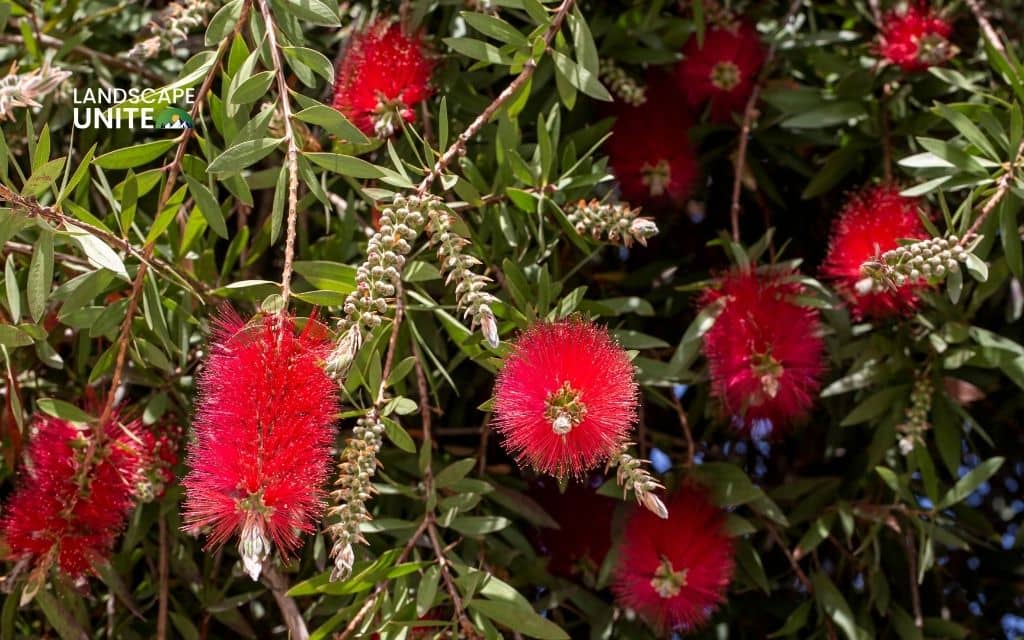
Trumpet Creeper (Campsis radicans)
Climbing vines with bold red trumpet-shaped flowers create vertical interest from summer through fall. These vigorous native vines can reach 30 – 40 feet, climbing via aerial rootlets. Trumpet creepers are magnets for hummingbirds but can be aggressive spreaders.
Plant in full sun to partial shade; hardy in zones 4-9. Provide sturdy support and prune regularly to control spread.
- Light: Full sun to partial shade
- Water: Low to moderate; drought-tolerant
- Mature Size: 30 – 40 ft. long
- Difficulty: Easy (but aggressive)
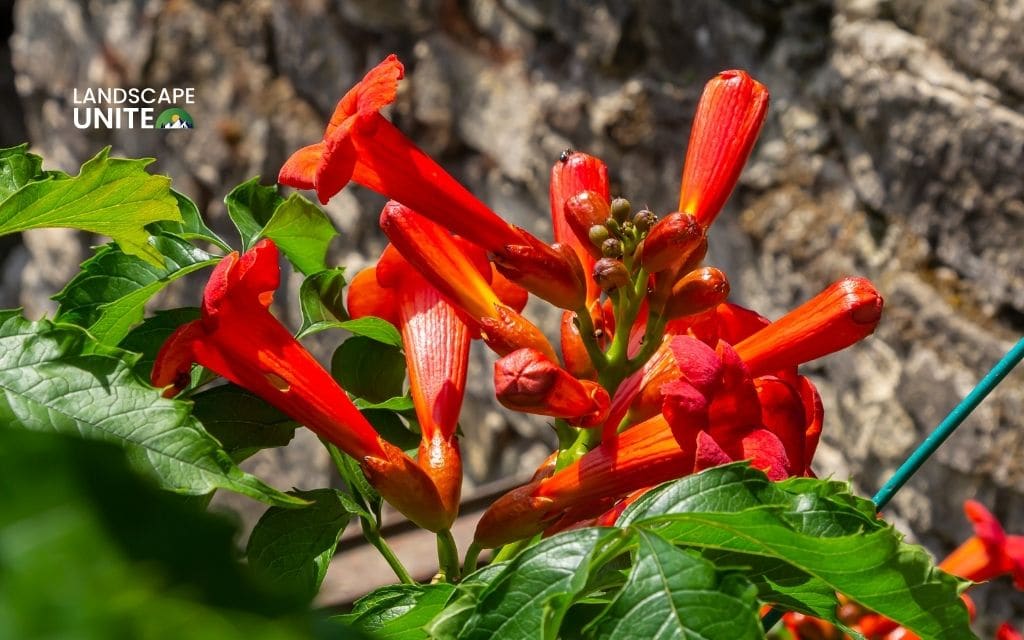
Scarlet Runner Bean (Phaseolus coccineus)
Edible vines with bright red flowers combine ornamental beauty with productive harvests. These fast-growing annual vines can reach 10-12 feet in a single season, making them perfect for covering fences or trellises.
The flowers attract hummingbirds, and the beans can be eaten fresh or dried. Plant in full sun after frost danger passes.
- Light: Full sun
- Water: Regular watering; keep moist
- Mature Size: 10 – 12 ft. long
- Difficulty: Easy
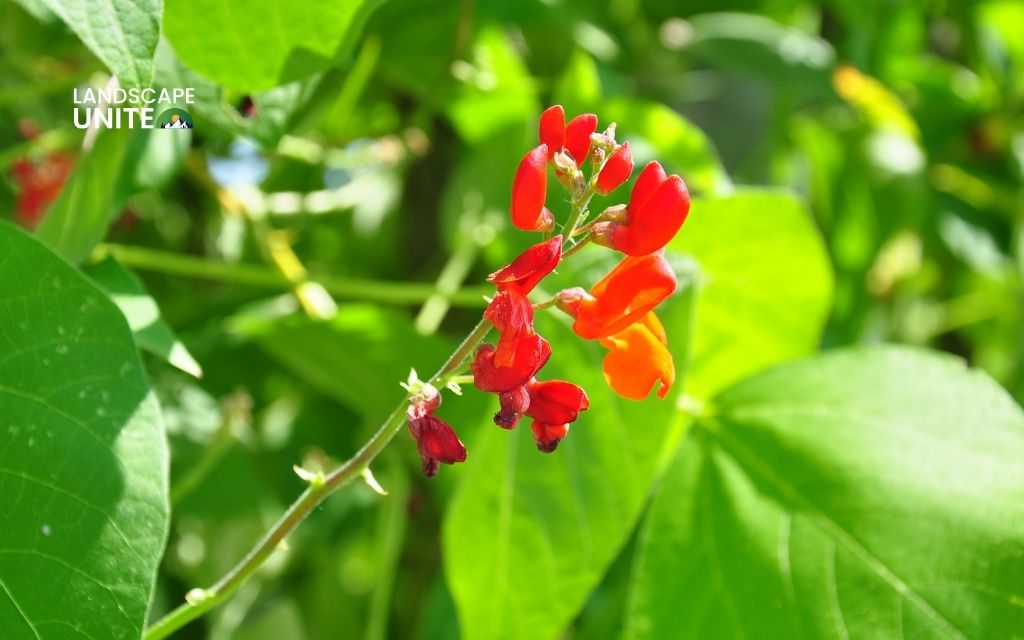
Pomegranate (Punica granatum)
Fruit trees with bright red flowers and edible fruits offer multiple seasons of interest. In late spring, pomegranates produce crinkled, orange-red flowers that develop into distinctive fruits by fall.
They prefer full sun and well-drained soil, tolerating drought and poor soil remarkably well. Hardy in zones 7-10; in colder zones, grow dwarf varieties in containers.
- Light: Full sun
- Water: Low to moderate; drought-tolerant
- Mature Size: 12-20 ft. tall, 12-20 ft. wide
- Difficulty: Easy to Moderate
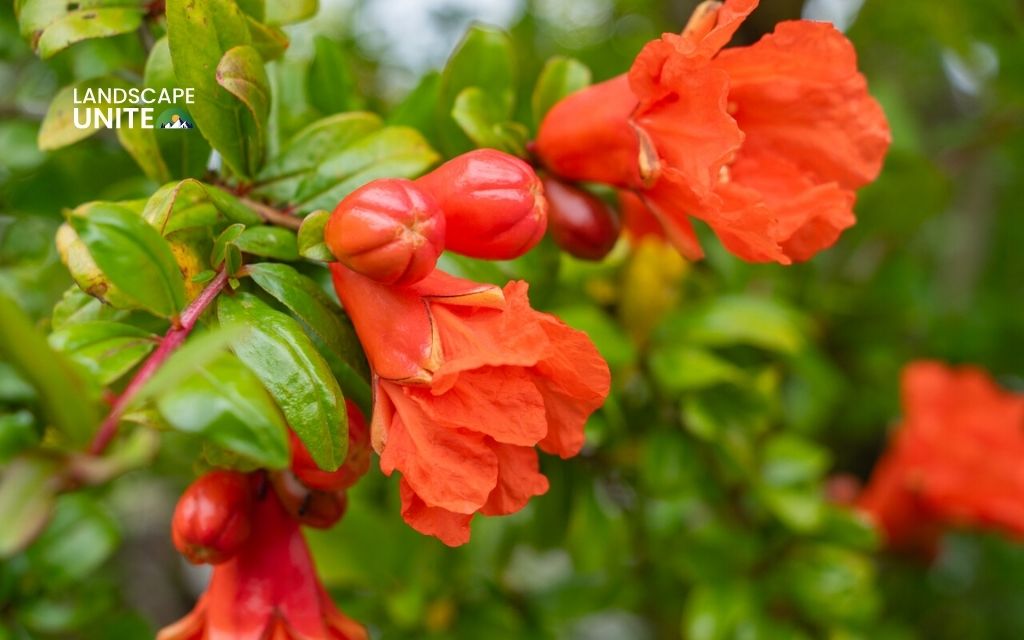
Why choose red plants for your garden?
Bold color & visual drama
Red plants create instant focal points that command attention across any landscape. The vibrant energy of red stands out dramatically against green foliage, making even small plantings feel impactful. Red pairs beautifully with white for crisp contrast, combines with yellow for warm, energetic displays, or works against dark foliage for sophisticated effects.
Seasonal appeal
Red plants shine in every season. Spring brings tulips, poppies, and flowering quince. Summer showcases zinnias, dahlias, roses, and salvias. Fall features chrysanthemums, ornamental grasses, and vibrant foliage from Japanese maples. Winter offers holly berries, camellia blooms, and evergreen shrubs with red-tinged leaves.
Create year-round interest by selecting varieties that bloom or display color in different seasons, ensuring your landscape always has visual appeal.
Versatility in garden design
Red flowering plants adapt to virtually any garden style. They work beautifully in formal gardens, cottage gardens, modern landscapes, naturalistic wildlife gardens, tropical designs, and even drought-tolerant xeriscapes. Container gardens benefit tremendously from red blooms in pots, window boxes, and hanging baskets.
Conclusion
With 50 options from compact annuals to towering trees, red plants offer endless possibilities for adding drama and energy to your garden. Whether you prefer delicate spring blooms, vibrant summer flowers, or year-round foliage interest, there’s a perfect variety for your climate and skill level.
From reliable geraniums and petunias to exotic hibiscus and bougainvillea, these plants transform ordinary spaces into extraordinary displays. With proper care, these magnificent red plants will reward you with years of stunning color that makes every season unforgettable.
Ready to explore more garden inspiration? Browse our complete landscape collection of planting guides and design tips to transform your outdoor space.
FAQs
What is a plant that is red?
Many plants feature red coloring. Popular flowering options include geraniums, roses, petunias, dahlias, and zinnias. For red foliage, consider Japanese maple ‘Bloodgood’, coleus ‘Redhead,’ or red fountain grass. Your best choice depends on your climate zone and whether you prefer flowers or foliage.
How to take care of anthurium plants indoors?
Anthuriums need bright, indirect light and temperatures of 65-80°F. Keep soil moist but not waterlogged using a well-draining mix. Maintain 60-80% humidity through misting or humidity trays. Fertilize monthly during the growing season with diluted balanced fertilizer. Wipe leaves regularly to prevent dust buildup and watch for pests.
Which plant is now having red plants?
Red flowering plants bloom seasonally by region. Spring brings tulips, poppies, and azaleas. Summer features roses, dahlias, zinnias, and hibiscus. Fall showcases chrysanthemums and red maple foliage. Winter offers camellias and poinsettias. The plants blooming “now” depend on your hardiness zone and current season.
What is a beautiful red flower called?
Many stunning red flowers exist: roses (classic choice), dahlias (dramatic blooms), peonies (romantic appeal), poppies (delicate beauty), amaryllis, hibiscus, calla lilies, tulips, and camellias. Each offers unique characteristics including fragrance, bloom size, season, and growing requirements for different garden needs.
What is a common houseplant with a red flower?
Anthurium (flamingo flower) is the most popular houseplant with red flowers, featuring glossy spathes and long-lasting blooms. Other options include holiday cactus with tubular red flowers, amaryllis bulbs for winter displays, compact red begonias, and poinsettias with red bracts. All bloom indoors with proper light, water, and temperature.
